To read this content please select one of the options below:
Please note you do not have access to teaching notes, art and tourism – a systematic review of the literature.
Tourism Review
ISSN : 1660-5373
Article publication date: 13 December 2022
Issue publication date: 20 January 2023
The purpose of this study is to present a review of published academic work on art and tourism. A distinction between papers researching tourism and mentioning art just as one of tourism activities and papers covering “art tourism” specifically is proposed.

Design/methodology/approach
The review is grounded on a content analysis of studies containing the words “art” and “tourism” published in the Scopus database. Moreover, to analyze papers specifically consisting of the term “art tourism” a theory‐context‐characteristics‐methods structure was used – the authors call these papers art–tourism-specific papers.
While the number of “art and tourism” papers has been increasing in the past 40 years, little is known about “art tourism” as an independent form of tourism. This study finds limited work on art tourists’ characteristics, preferences and behaviors as costumers. No art-based research and little research with visual representations was found. Artists are very rarely participants of art tourism research.
Research limitations/implications
Most research is conceptual, and little applied research can be identified. Importantly, besides synthesizing and critically assessing the current corpus of knowledge on art tourism, this review presents a final roadmap with directions for future research. One of the limitations of this review is that only studies included in the Scopus database and published in English were considered.
Originality/value
To the best of the authors’ knowledge, this study provides the first comprehensive systematic review of published academic research on art and tourism in the past 40 years. The results of this study offer directions to future art tourism researchers.
本文的目的是回顾已发表的有关艺术和旅游的学术著作。 提出了在研究旅游的论文中将仅将艺术作为旅游活动之一提及的论文与专门涵盖“艺术旅游”的论文进行区分。
该回顾是基于对 Scopus 数据库中发表的包含“艺术”和“旅游”一词的文章的内容分析。此外, 为了分析专门由术语“艺术旅游”组成的论文, 我们使用了理论-背景-特征-方法的结构——我们将这些论文称为艺术旅游特定论文。
虽然过去四十年来“艺术与旅游”论文的数量一直在增加, 但人们对“艺术旅游”作为一种独立的旅游形式知之甚少。 我们发现关于艺术游客的特征、偏好和作为顾客的行为的工作有限。 没有发现基于艺术的研究, 也没有发现很少的视觉表现研究。 艺术家很少是艺术旅游研究的参与者。
大多数研究都是概念性的, 很少有应用研究可以被识别出。重要的是, 除了综合性地批判和评估当前关于艺术旅游的知识库外, 本次回顾还提出了一个最终路线图, 并为未来的研究提供了方向。本回顾的局限性之一是仅考虑了 SCOPUS 数据库中包含的并以英文发表的文章。
本研究首次全面系统地回顾了过去四十年来发表的有关艺术和旅游的学术研究。本研究结果为未来的艺术旅游研究者提供了方向。
Objetivo (límite de 100 palabras)
El propósito de este artículo es presentar una revisión de los trabajos académicos publicados sobre arte y turismo. Se propone una distinción entre los trabajos que investigan el turismo y mencionan el arte sólo como una de las actividades turísticas Y los trabajos que cubren específicamente el “turismo artístico”.
Diseño/metodología/enfoque (límite 100 palabras)
Esta revisión se basa en un análisis de contenido de los artículos que contienen las palabras “arte” y “turismo” publicados en la base de datos Scopus. Además, para analizar los artículos que contenían específicamente el término “turismo artístico” se utilizó una estructura Teoría-Contexto-Características-Métodos - llamamos a estos artículos específicos de turismo artístico.
Conclusiones (límite de 100 palabras)
Aunque el número de trabajos sobre “arte y turismo” ha aumentado en los últimos cuarenta años, se sabe poco sobre el “turismo artístico” como forma independiente de turismo. Encontramos trabajos limitados sobre las características, preferencias y comportamientos de los turistas de arte como clientes. No se ha encontrado ninguna investigación basada en el arte y poca investigación con representaciones visuales. Los artistas rara vez participan en las investigaciones sobre turismo artístico.
Limitaciones/implicaciones de la investigación (límite 100 palabras)
La mayor parte de las investigaciones son conceptuales, y se puede identificar poca investigación aplicada. Es importante destacar que, además de sintetizar y evaluar críticamente el corpus actual de conocimientos sobre el turismo artístico, esta revisión presenta una hoja de ruta final con directrices para futuras investigaciones. Una de las limitaciones de esta revisión es que sólo se han considerado los artículos incluidos en la base de datos SCOPUS y publicados en inglés.
Originalidad/valor (límite 100 palabras)
Este estudio proporciona la primera revisión sistemática exhaustiva de la investigación académica publicada sobre arte y turismo en los últimos cuarenta años. Los resultados de este estudio ofrecen orientaciones a los futuros investigadores del turismo artístico.
- Art tourism
- Cultural tourism
- Art-based research
- Art destination
- Turismo artístico
- Turismo cultural
- Investigación basada en el arte
- Turismo de arte
- Destino de arte
Acknowledgements
Authors have contributed equally in each aspect of the research process. 1. Conception or design of the work – Nataša Slak Valek and Paolo Mura, 2. Data collection – Nataša and Paolo, 3. Data analysis and interpretation – Nataša and Paolo, 4. Drafting the article – Nataša and Paolo, 5. Critical revision of the article – Nataša and Paolo, 6. Final approval of the version to be published – Nataša and Paolo.
Slak Valek, N. and Mura, P. (2023), "Art and tourism – a systematic review of the literature", Tourism Review , Vol. 78 No. 1, pp. 273-290. https://doi.org/10.1108/TR-05-2022-0214
Emerald Publishing Limited
Copyright © 2022, Emerald Publishing Limited
Related articles
We’re listening — tell us what you think, something didn’t work….
Report bugs here
All feedback is valuable
Please share your general feedback
Join us on our journey
Platform update page.
Visit emeraldpublishing.com/platformupdate to discover the latest news and updates
Questions & More Information
Answers to the most commonly asked questions here
Art, tourism
- Living reference work entry
- Later version available View entry history
- First Online: 01 January 2015
- Cite this living reference work entry

- Karolina Buczkowska 3 &
- Magdalena Banaszkiewicz 4
310 Accesses
1 Citations
Art, as a vast subdivision of culture, is composed of many creative endeavors and disciplines. It encompasses visual/plastic arts (traditional fine, modern fine, modern visual, applied, decorative, literature, and music) and performing arts. To the world of tourism, it brings “style, culture, beauty, and a sense of continuity of living” (Heather Zeppel and Michael Hall, in Smith 2009 : 121), while tourism “arguably creates a channel whereby new art forms can gain support (both financial and moral), and helps to broaden the audience for the arts” (Smith 2009 : 22–23).
The relationship between art and tourism has been close since ancient times and tourists have had very frequent contact with art of various centuries and countries; similarly artists have always traveled. The two words have appeared in several combinations such as “arts tourists”, “artists-tourists” (artists as tourists), “tourists as an inspiration for artists”, and “tourist art”.
Arts tourists
Arts tourists, as recipients...
This is a preview of subscription content, log in via an institution to check access.
Access this chapter
Institutional subscriptions
Crowley, D. 2000 Art. In Encyclopedia of Tourism, J. Jafari, ed., pp.30-31. London: Routledge.
Google Scholar
Hughes, H. 2003 Arts, Entertainment and Tourism. Burlington: Buttleworth-Heinemann.
Jules-Rosette, B. 1984 The Messages of Tourist Art: An African Semiotic System in Comparative Perspective . New York: Plenum Press.
Book Google Scholar
Smith, M. 2009 Issues in Cultural Tourism Studies. London: Routledge.
Tribe, J. 2008 The Art of Tourism. Annals of Tourism Research 35:924-944.
Article Google Scholar
Wieczorkiewicz, A. 2012 Apetyt Turysty. O Doswiadczaniu Swiata w Podrozy (The Appetite of a Tourist. The Experience of the World in Travel). Krakow: Universitas.
Download references
Author information
Authors and affiliations.
Poznan University School of Physical Education, Poznan, Poland
Karolina Buczkowska
Jagiellonian University, Cracow, Poland
Magdalena Banaszkiewicz
You can also search for this author in PubMed Google Scholar
Corresponding author
Correspondence to Karolina Buczkowska .
Editor information
Editors and affiliations.
School of Hospitality Leadership, University of Wisconsin-Stout, Menomonie, Wisconsin, USA
Jafar Jafari
School of Hotel and Tourism Management, The Hong Kong Polytechnic University, Hong Kong, Hong Kong SAR
Honggen Xiao
Rights and permissions
Reprints and permissions
Copyright information
© 2014 Springer International Publishing Switzerland
About this entry
Cite this entry.
Buczkowska, K., Banaszkiewicz, M. (2014). Art, tourism. In: Jafari, J., Xiao, H. (eds) Encyclopedia of Tourism. Springer, Cham. https://doi.org/10.1007/978-3-319-01669-6_236-1
Download citation
DOI : https://doi.org/10.1007/978-3-319-01669-6_236-1
Received : 04 September 2014
Accepted : 04 September 2014
Published : 24 September 2015
Publisher Name : Springer, Cham
Online ISBN : 978-3-319-01669-6
eBook Packages : Springer Reference Business and Management Reference Module Humanities and Social Sciences Reference Module Business, Economics and Social Sciences
- Publish with us
Policies and ethics
Chapter history
DOI: https://doi.org/10.1007/978-3-319-01669-6_236-4
DOI: https://doi.org/10.1007/978-3-319-01669-6_236-3
DOI: https://doi.org/10.1007/978-3-319-01669-6_236-2
DOI: https://doi.org/10.1007/978-3-319-01669-6_236-1
- Find a journal
- Track your research

10 Great Travel Destinations for Art Lovers
From a japanese art island to a creative colony among ancient olive groves in israel, these are the global art towns, big and small, we’d happily visit..
- Copy Link copied

Art meets nature at Brazil’s Instituto Inhotim, home to one of the largest collections of contemporary art in the country.
Photo by Brendon Campos
New York, London, Paris, Berlin, Los Angeles, Florence, Miami Beach, Hong Kong, São Paulo—these cities are all home to blockbuster art markets, creative superstars, and museums as famous as the works they house. We love these places, but we also love art destinations outside of the art-world orbit: places with an air of mystery, a whiff of a pilgrimage, a winking nonconformity, a love of experimentation, and a tight-knit sense of community.
Read on for 10 great destinations, big and small, art lovers should bookmark for their next vacation.

‘Your Rainbow Panorama’ tops the AroS Art Museum in Aarhus, Denmark.
Photo by Shutterstock
Aarhus, Denmark
In the heart of Aarhus, Denmark’s second-largest city and one of its oldest (dating to the 8th century), a colossal rainbow ring rises above the city. This is artist Olafur Eliasson’s installation, Your Rainbow Panorama, a walkway circling and capping the ARoS Art Museum, itself a jewel among Aarhus’s many cultural institutions. The museum is home to another art colossus, the crouching Boy sculpture by Australian artist Ron Mueck, and it hosts collections of Danish art from the 18 th century to today, as well as the work of international artists. Art lovers can wander among pieces by London-based, British-Palestinian Mona Hatoum, known for her probing and glowing installations; Japanese photographer Miwa Yanagi; and New York–based Tony Oursler, who has been innovating video and installation art since the 1970s.
In Aarhus, self-dubbed “Smilets By” (Danish for “City of Smiles”) and the “World’s Smallest Big City,” ARoS is just a jumping-off point for a smørrebrød (smorgasbord) of art destinations and happenings. Spiral out from the museum and see the city’s famous modern architecture, such as The Iceberg , a seaside apartment building that lives up to its name, and the grass-covered Moesgaard Museum . We love Charlotte Fogh Gallery , a Danish and international contemporary art gallery; the Højkant art collective and design shop full of cheeky creations; and the intimate PS Art Gallery and studio in a green, half-timbered, 17th-century home in the city’s Latin Quarter.
Juxtapose all this contemporary art and design with Den Gamle By (The Old Town), an open-air folk museum comprised of 75 historic buildings relocated from across Denmark, cobbled streets, and Danes dressed in period clothing baking bread and chopping wood. You can eat an actual smørrebrød here, as well as fried fish and frikadeller (Danish meatballs).

Chris Burden’s ‘Beam Drop’ (2008) was re-created at Inhotim; the original work was on display in New York in 1984.
Brumadinho, Brazil
Brumadinho is home to the Xanadu of the art world: the Instituto Inhotim , a contemporary art museum and sculpture park in a 346-acre private botanical garden founded by mining magnate and art patron Bernardo de Mello Paz.
Celebrating 15 years in 2021, the institute is one of the largest outdoor art spaces in the world, placing hundreds of giants of the art world alongside thousands of giants of the plant world, from octopus agave to ponytail palm and swamp cypress. The garden hosts more than 700 works by 60 artists, including Brazil’s own beloved boundary-defying Hélio Oiticica. As Oiticica intended, visitors can walk through his Magic Square #5 (1977), a colorful abstracted “public plaza” built of cement, glass, and stone. You could spend weeks wandering the grounds, a crash course in modern and contemporary large-scale art, studying the likes of Elisa Bracher’s eucalyptus and cedar wood Embrionário , going tête-à-tête with Paul McCarthy’s Pinocchio Block Head , gazing through Olafur Eliasson’s mirrored Viewing Machine, and falling in love with your own reflection at Yayoi Kusama’s Narcissus Garden Inhotim, 750 stainless steel orbs bobbing in a reflecting pool.
While the garden is the main draw, Instituto Inhotim has many noteworthy pieces in its indoor gallery as well, such as the blue-and-white tile room Celacanto provoca maremoto by Adriana Varejão , the sci-fi-inspired plant and mirror maze structure Vegetation Room Inhotim by Cristina Iglesias , and the enforested glass geodesic dome by Matthew Barney .
There are several places to eat across the sculpture park and the institute has many recommendations for nearby lodging, including Villa Rica , decorated with local art, or Villa Domaso , surrounded by lush nature.

Zeitz MOCAA has become a destination unto itself in Cape Town, South Africa.
Photo by Kiev.Victor/Shutterstock
Cape Town, South Africa
Rising from the Victoria & Alfred Waterfront, with Table Mountain as a backdrop, is the world’s largest museum devoted to contemporary African art: the Zeitz Museum of Contemporary Art Africa , commonly known as Zeitz MOCAA. First things first, the museum itself is a marvel , a towering structure revamped from the historic Grain Silo Complex with an interior that looks like an abstracted concrete-and-glass honeycomb.
Zeitz MOCAA is home to works by some of the continent’s leading artists such as Athi-Patra Ruga and Mary Sibande of South Africa, Njideka Akunyili Crosby of Nigeria, Ghada Amer of Egypt, and Nandipha Mntambo of Swaziland. The permanent collection also includes works by artists of the African Diaspora, like Kehinde Wiley and Frohawk Two Feathers, both of the U.S.
But Cape Town was an artist’s haven long before the arrival of MOCAA in 2017. The Woodstock neighborhood alone, with its pink town hall, is home to several renowned galleries dedicated to contemporary African artists including SMAC , Goodman Gallery , Stevenson Gallery (all of which have sister galleries in another top South African art destination, Johannesburg).
Cape Town is also delightfully crowded with public art, such as Es Devlin’s installation Zoetrope at the Waterfront and Arch for Arch, a woven wooden structure next to St. George’s Cathedral that honors Archbishop Desmond Tutu. The organization Baz Art hosts the annual International Public Art Festival , which in 2021 focused on painting murals in the Salt River neighborhood . There are also several art road trips worth taking from the Cape. Drive inland through mountainous wine country (many of the vineyards you’ll pass have their own fantastic art collections) to Stellenbosch, an oak-lined university town packed with art studios and the awe-inspiring Dylan Lewis Sculpture Garden .

Mismatched pastel buildings that look like scoops of gelato along the water in Collioure, France.
Photo by Pani Garmyder/Shutterstock
Collioure, France
Legend has it that Henri Matisse said the quality of light is just different— magical —in Collioure, a laidback and ancient fishing town on the French Mediterranean 15 miles from Spain. Matisse and André Derain would summer here and become the first fauves (French for “wild beasts”), leaders of fauvism, the early 19th-century art movement known for its bold colors and brushstrokes, an unruly descendent of Impressionism. Matisse’s famous Open Window (1905) and Derain’s Fishing Boats (1905) were painted here, among many more fauvist works.
Collioure’s very petit harbor still captures the brilliant sunlight, bouncing off a 13 th -century castle and fortress and layers of mismatched pastel buildings that look like scoops of gelato along the water. Visitors can see the town through the artists’ perspectives along the Chemin du Fauvism, which features both empty bronze frames that outline the views of their most famous canvases, as well as reproductions. The Maison du Fauvism offers guided tours.
Keep cool with an actual scoop of gelato—countless gelaterias line the streets and try a bite of Catalan fare at Le Neptune overlooking the bay or the Templiers restaurant and hotel, a cozy spot with a bar made from a ship hull and walls lined salon-style with paintings.

Bronze sculptures by the residents of Ein Hod, Israel, dot the surrounding landscape.
Photo by Leonid Radashkovsky/Shutterstock
Ein Hod, Israel
Within hilly olive groves, tucked between the Mediterranean sea and Mount Carmel, is Ein Hod , a small artist colony established in 1953 by artist Marcel Janco , one of the founders of the avant-garde dada movement, which formed in reaction to World War I. Legend has it that Janco toured Israel, sketchbook in hand, and stumbled across the then-abandoned village and found it could be the perfect refuge for artists.
Today Ein Hod , 12 miles south of Haifa, has about 650 residents—mostly painters, sculptors, jewelers, architects, and artisans—and the landscape is dotted with their handiwork: outdoor bronze sculptures (look for Couple in a Sardine Can by Ben Levy), murals, studios, galleries, and workshops that offer classes for visitors. See the abstract colorations of Miriam-Ruth Sernoff Frohlich at the Sernoff-Frohlich Gallery Of Fine Art , the soulful book art of Nechama Levendel at the Karoyan Gallery , and the work of many locals under one roof at the Artists Gallery Ein Hod .
This tiny bohemian enclave is also home to two museums, the Nisco Museum of Mechanical Music and the Janco-Dada Museum , created in 1983 to honor the work and vision of the colony’s founder. This museum features the restored stone-arch studio of Janco and the DadaLab , where museumgoers can try their own hand at creating the absurdist, convention-defying art that defined this movement. Since 1990, Ein Hod has hosted an international Sculpture Biennale , inviting artists to install large-scale works outside amid ancient olive trees.
You can eat with the locals in one of the village’s classic stone buildings at Café Ein Hold. While larger hotels are available in nearby Haifa, Ein Hod itself offers a handful of quaint and eclectic apartments for rent, many with views of the Mediterranean.

Hobart’s Museum of Old and New Art is
Photo by C. de la Cruz/Shutterstock
Hobart, Tasmania
Looking out from the Berriedale peninsula onto the River Derwent is the Museum of Old and New Art (MONA), or as founder—businessman, art collector, and high-stakes gambler David Walsh—calls it: a subversive adult Disneyland.
MONA is as irreverent as its benefactor, its website describing the museum’s everchanging identity as a “really elaborate marketing stunt” and “somewhere people can come to say ‘not sure about the art but the architecture is amazing.’”
And many are not sure about the art : MONA has the work of some of the biggest shock jocks of the art world: Hermann Nitsch’s bloody 6-Day-Play videos and Wim Delvoye’s stinking waste machine that is Cloaca Professional, to name a few.
Regardless of your take, the museum has helped put Hobart’s art scene on the map, bringing deserved attention to other art spaces like the Art Mob , which specializes in Tasmanian and Australian aboriginal art by the likes of Queenie McKenzie and Dennis Nona. Across the harbor are the contemporary fine art Despard and Handmark galleries, the latter of which is part of the bustling Salamanca Arts Centre , a transformed warehouse space home to several galleries and exhibition spaces, a theater, and the jewelry and metal collective Hammer & Hand , as well as public art such as We Are Made of Stardust by Michaela Gleave and Escape Pod by Colin Langridge. Stay in the neighborhood at the Henry Jones Art Hotel , which features contemporary art by Tasmanian artists in its rooms.

Kilns have been firing in this hilly city of Jingdezhen, China, known as the “Porcelain Capital of the World.”
Photo by CYSUN/Shutterstock
Jingdezhen, China
Leading ceramics artists and students worldwide travel to Jingdezhen, China, the “Porcelain Capital of the World,” where the ruins of ancient kilns meet contemporary factories and galleries. For more than 1,700 years and many imperial reigns, kilns have been firing in this hilly city of Jiangxi province along the Chang River, where ceramic masters have innovated technologies to produce the most coveted china, such as the emblematic blue and white pottery developed during the Ming Dynasty.
The stunning Jingdezhen Imperial Kiln Museum —shaped like ancient kilns in red brick, and the Jingdezhen Ceramic Industry Heritage Museum , help put the expansive history of this art industry in context. The industry, however, is alive and well today, cultivating the next generation of ceramicists at the renowned Jingdezhen Ceramic Institute and employing 30,000 people at outfits like the Porcelain Sculpture Factory in the Eastern suburbs or in the nearby Sanbao International Porcelain Art Village filled with artist studios and workshops. The Pottery Workshop , run by artist and curator Caroline Cheng , is an education center and hub for young artists in Jingdezhen, known as jingpiao . Every Saturday morning, the jingpiao sell their wares—traditional pottery, jewelry, contemporary art—at the Pottery Workshop Creative Market .
Countless ceramic artists and designers have their practices in the city such as Cheng herself, plus Wan Liya , Juz Kitson , Lin Wang , Robin Best , and Ryan LaBar . Walk down the Taoxichuan, known as the Ceramic Art Avenue, to peak into studios, galleries, and markets, and try some classic Jiangxi fare such as Lushan San Shi and fish banquets. The Fairfield by Marriot Jingdezhen hotel is near many of these attractions, and there are a handful of gorgeous Airbnb options .

An art lover’s trip to Japan has to include Naoshima in the Seto Inland Sea.
Photo by N_FUJITA/Shutterstock
Naoshima, Japan
There is a string of tiny flecks of land in the Seto Inland Sea that are teaming with museums, architectural marvels, and art installations. Naoshima, commonly referred to as Japan’s art island, home of the Benesse Art Site , leads the pack. Here, massive sculptures such as Lee Ufan’s Porte vers l’infini (2019) and Beatriz Millhaze’s Yellow Flower Dream (2018) dot the landscape creating a fine art playground. (Until recently, one of Yayoi Kusama’s massive pumpkin sculptures sat on a pier before a typhoon swept it out to sea . Benesse Art Site is in the process of restoring it.)
Then there are the museums and galleries: the mind-bending subterranean Chichu Art Museum designed by architect Tadao Ando housing works by Claude Monet and James Turrell; the Benesse House Museum , which melds a hotel and exhibition space with nature (with a restaurant serving kaiseki meals that rival the art for presentation); the kooky art facility Naoshima Bath where—you guessed it—visitors can take a bath surrounded by the artwork of Shinro Ohtake; and the Miyanoura Gallery 6 in the site of a former pachinko parlor once popular with islanders.
If you’re willing to island hop, head to Teshima to see large-format paintings in the Teshima Yokoo House (named for artist Tadanori Yokoo) and Inujima for an art museum housed in a old copper refinery .

You could spend a full day just exploring Georgia O’Keeffe’s artwork in Santa Fe, New Mexico.
Photo by Fred Mays/Shutterstock
Santa Fe, New Mexico
One of the oldest cities in the U.S. (older than the country itself, with a founding date of 1607) Santa Fe and its iconic pueblo architecture encompass many art scenes and histories, from the vast indigenous collections of the Institute of American Indian Arts (IAIA) to the electro-pop experiences of Meow Wolf to the storied career of Georgia O’Keeffe who was so deeply influenced by the New Mexico landscape.
Housed in a historic Peublo Revival-style post office downtown, the IAIA’s Museum of Contemporary Native Arts stewards the National Collection of Contemporary Native Art, featuring 9,000 artworks created since 1962 including pieces by legends such as George Morrison, Helen Hardin, and Fritz Scholder. From here, walk past the Santa Fe Plaza to the Georgia O’Keeffe Museum to see up-close and personal Black Hollyhock Blue Larkspur (1930), Pelvis IV (1944), and Spring (1948), among others. O’Keeffe fans can stay at the Abiquiú Inn , next to the The O’Keeffe Welcome Center housed in the artist’s former home and residence.
Around Canyon Road, you’ll find 80-plus galleries including Turner Caroll Gallery —whose international roster of artists includes Judy Chicago, Wanxin Zhang, and Swoon; Nedra Matteucci Galleries with its renowned sculpture garden; and the art collective and gallery Cielo Handcrafted , with goods including stoneware ceramics, leather totes, and silver jewelry.
Down Cerrillos Road, follow the neon glow of Meow Wolf’s House of Eternal Return , an “explorable art experience,” a sort of dayglo haunted house with more than 70 immersive rooms.

The streets of tiny Todos Santos are full of galleries and shops stacked with handmade ceramics, metal work, and beautiful textiles.
Photo by Arturo Verea/Shutterstock
Creativity and Tourism: The state of the art

"The rapidly developing relationship between tourism and creativity, arguably heralds a ‘creative turn’ in tourism studies. Creativity has been employed to transform traditional cultural tourism, shifting from tangible heritage towards more intangible culture and greater involvement with the everyday life of the destination. The emergence of ‘creative tourism’ reflects the growing integration between tourism and different placemaking strategies, including promotion of the creative industries, creative cities and the ‘creative class’. Creative tourism is also arguably an escape route from the serial reproduction of mass cultural tourism, offering more flexible and authentic experiences which can be co-created between host and tourist. However the gathering critique also highlights the potential dangers of creative hype and commodification of everyday life."
Related Papers
greg richards
In the past forty years the relationship between culture, economy and society has changed beyond recognition. Culture has grown beyond its original socialisation role to become the oil of the new economy and a vital reservoir of symbolic resources that feeds tourism production and consumption. Heritage has emerged as a force for urban and rural renewal and preservation, become a global industry in its own right. More recently the growth of the creative economy has been marked by the increasing intangibilisation of culture and heritage, as they have become vital markers of symbolic value. In the field of tourism, this change has been marked by the continued growth of cultural tourism, and the recent fragmentation of cultural tourism into a number of sub-fields, including film tourism, gastronomic tourism, festival tourism, etc. (Richards, 2001; Hjalager and Richards, 2002). The growing importance of creativity and intangible heritage in tourism has also been marked by the development of a specific sub-field of ‘creative tourism’ (Richards and Raymond, 2000). Creative tourism arguably represents a departure from traditional models of cultural and heritage tourism, moving away from tangible heritage as the key asset towards creative and symbolic capital. This paper examines the development of creative tourism in recent years, tracing its trajectory from a sub-field of cultural tourism towards an emerging field and philosophy of tourism.
Paper presented at the International Conference on Creative Tourism, Barcelona December, 9th - 10th 2010. Creative tourism is a concept that only formally defined a decade ago, but in the intervening years it has seen a significant growth worldwide. The range of presentations at this conference on different creative tourism programmes from all corners of the globe is a clear indication of how widespread it now is. In this presentation I will try and set out some of the reasons for this growth, the different forms of creative tourism that have developed and the challenges that remain for those involved in this new sector of tourism. My basic argument is that the growth of creative tourism has been driven by both production and consumption related forces, and that the maximum benefit can be derived by creatively combining the efforts of both producers and consumers to develop new experiences that both engage and transform participants and host communities alike.
A Research Agenda for Creative Tourism
Nancy Duxbury
greg richards , Lénia Marques
This paper provides an overview of the contributions to special issue of the Journal of Tourism Consumption and Practice entitled „Exploring Creative Tourism‟. Creative tourism has grown rapidly in the past decade, reflecting the growing desire of consumers to develop their own creative potential and to attach themselves to creative networks, as well as the need for creative producers, cities and regions to profile themselves in an increasingly crowded global market. The case studies in the special issue examine creative tourism in a range of different contexts and present a range of models of creative tourism development in fields such as music, art, heritage and crafts. Creative tourism can therefore be viewed as a form of networked tourism, which depends on the ability of producers and consumers to relate to each other and to generate value from their encounters. Keywords: creativity, creative tourism, cultural tourism, creative experiences, network society
This chapter reviews the development of creative tourism over the past decade and identifies major trends and practices both from a production and consumption perspective. In particular, this review highlights the shift from tangible to intangible cultural and creative resources as the basis of cultural and creative tourism experiences. A number of different models of creative tourism development are reviewed to illustrate these principles.
Presentation at the World Travel Market Conference on ‘Creative Tourism: All that you need to know about this growing sector’, November 3rd 2015. Creative tourism is a relatively new niche that is being taken up by destinations around the world. The basic reason for this is the growing dissatisfaction with traditional models of tourism development, and the realisation that the creativity of both hosts and tourists is an important potential resource for the sustainable development of tourism. This brief presentation reviews the important features of creative tourism and how it is changing people’s lives.
Creative Tourism: Activating Cultural Resources and Engaging Creative Travellers
Creative tourism is part of a number of general trends towards more creative, relational, and locally focused styles of travel. For example, the 'live like a local' trend encourages travellers to reject the 'role' of tourist and to integrate into everyday life and culture at the destination, reciprocated by local recognition of 'temporary residents' (Richards and Marques, 2018). This chapter reviews the development of the creative tourism concept, and considers potential future trajectories.
Journal of Tourism Consumption and Practice
greg richards , Daniela Jelinčić , Eliana Messineo
This special issue of the Journal of Tourism Consumption and Practice considers many different facets of the creative tourism phenomenon, and examines the ways in which it has been developed in a range of places, ranging from the frozen north of Canada to the searing heat of Mali. The papers that compose this special issue identify trends and challenges in creative tourism development and, despite the emergent critical thoughts on the subject, they tend to emphasise the positive aspects.
Routledge Handbook of Cultural Tourism
This chapter traces the development of creative tourism as new form of cultural tourism. This trend has been stimulated by the growth of new consumption patterns, by more involved and skilled forms of tourism activity, and by changes in the production of tourism, such as the development of the experience economy. Arguably creative tourism also provides some answers to the increasing problems experienced in cultural tourism development, which is rapidly becoming another form of mass tourism. The chapter outlines the different forms that creative tourism can take, ranging from interactive workshops and learning experiences to creative backdrops for tourism activity. Illustrations of creative tourism forms are taken from creative tourism networks, workshops, creative spaces, cultural itineraries and creative events.
Exploring Creative Tourism, Journal of Tourism Consumption and Practice
Lénia Marques , greg richards , Eliana Messineo
This special issue of the Journal of Tourism Consumption and Practice considers many different facets of the creative tourism phenomenon, and examines the ways in which it has been developed in a range of places, ranging from the frozen north of Canada to the searing heat of Mali. The papers that compose this special issue identify trends and challenges in creative tourism development and, despite the emergent critical thoughts on the subject, they tend to emphasise the positive aspects. Journal of Tourism Consumption and Practice, Volume 4, 2012
RELATED PAPERS
Revista Iberoamericana
Hugo Verani
Soudni lekarstvi / casopis Sekce soudniho lekarstvi Cs. lekarske spolecnosti J. Ev. Purkyne
Bülent Eren
Pusat Kurikulum dan Perbukuan, Balitbang, Kemendikbud.
Zainul Imron
Vernon Cooray
Victor Petrenko
Journal of Vacuum Science & Technology B: Microelectronics and Nanometer Structures
Evidence-Based Complementary and Alternative Medicine
patrick Engeu ogwang
Devin Arnouly Putra
Téoros: Revue de recherche en tourisme
anne choquet
GrowUpWork Mạng giới thiệu việc làm tại Nhật Bản hàng đầu Việt Nam
Determinasi Harga Emas dan Indeks Sektor Keuangan
STMT Malahayati
Molecular Cancer Therapeutics
Habib Hamidi
Fabrizio Freni
International Council for Small …
Christophe Schmitt
Nucleic Acids Research
Farzin Farzaneh
Wilmer GomeZ
Journal of Visualized Experiments
Fidan Safira
INTERNATIONAL CONFERENCE ON MULTIMODAL INTERACTION
Mimi Bocanegra
Oldowan: rather more than smashing stones
Jack Harris
Historisk tidsskrift
Ole-Albert Rønning Nordby
Polymer Science Series B
Yaroslav V Kudryavtsev
nternational journal of advanced research in computer and communication engineering
Santwana Gudadhe
Clinical & Experimental Metastasis
Johannes Eble
RELATED TOPICS
- We're Hiring!
- Help Center
- Find new research papers in:
- Health Sciences
- Earth Sciences
- Cognitive Science
- Mathematics
- Computer Science
- Academia ©2024
UN Tourism | Bringing the world closer
Ethics, culture and social responsibility.
- Global Code of Ethics for Tourism
- Accessible Tourism
Tourism and Culture
- Women’s Empowerment and Tourism
share this content
- Share this article on facebook
- Share this article on twitter
- Share this article on linkedin
The convergence between tourism and culture, and the increasing interest of visitors in cultural experiences, bring unique opportunities but also complex challenges for the tourism sector.
“Tourism policies and activities should be conducted with respect for the artistic, archaeological and cultural heritage, which they should protect and pass on to future generations; particular care should be devoted to preserving monuments, worship sites, archaeological and historic sites as well as upgrading museums which must be widely open and accessible to tourism visits”
UN Tourism Framework Convention on Tourism Ethics
Article 7, paragraph 2
This webpage provides UN Tourism resources aimed at strengthening the dialogue between tourism and culture and an informed decision-making in the sphere of cultural tourism. It also promotes the exchange of good practices showcasing inclusive management systems and innovative cultural tourism experiences .
About Cultural Tourism
According to the definition adopted by the UN Tourism General Assembly, at its 22nd session (2017), Cultural Tourism implies “A type of tourism activity in which the visitor’s essential motivation is to learn, discover, experience and consume the tangible and intangible cultural attractions/products in a tourism destination. These attractions/products relate to a set of distinctive material, intellectual, spiritual and emotional features of a society that encompasses arts and architecture, historical and cultural heritage, culinary heritage, literature, music, creative industries and the living cultures with their lifestyles, value systems, beliefs and traditions”. UN Tourism provides support to its members in strengthening cultural tourism policy frameworks, strategies and product development . It also provides guidelines for the tourism sector in adopting policies and governance models that benefit all stakeholders, while promoting and preserving cultural elements.
Recommendations for Cultural Tourism Key Players on Accessibility
UN Tourism , Fundación ONCE and UNE issued in September 2023, a set of guidelines targeting key players of the cultural tourism ecosystem, who wish to make their offerings more accessible.
The key partners in the drafting and expert review process were the ICOMOS International Cultural Tourism Committee and the European Network for Accessible Tourism (ENAT) . The ICOMOS experts’ input was key in covering crucial action areas where accessibility needs to be put in the spotlight, in order to make cultural experiences more inclusive for all people.
This guidance tool is also framed within the promotion of the ISO Standard ISO 21902 , in whose development UN Tourism had one of the leading roles.
Download here the English and Spanish version of the Recommendations.
Compendium of Good Practices in Indigenous Tourism

The report is primarily meant to showcase good practices championed by indigenous leaders and associations from the Region. However, it also includes a conceptual introduction to different aspects of planning, management and promotion of a responsible and sustainable indigenous tourism development.
The compendium also sets forward a series of recommendations targeting public administrations, as well as a list of tips promoting a responsible conduct of tourists who decide to visit indigenous communities.
For downloads, please visit the UN Tourism E-library page: Download in English - Download in Spanish .
Weaving the Recovery - Indigenous Women in Tourism

This initiative, which gathers UN Tourism , t he World Indigenous Tourism Alliance (WINTA) , Centro de las Artes Indígenas (CAI) and the NGO IMPACTO , was selected as one of the ten most promising projects amoung 850+ initiatives to address the most pressing global challenges. The project will test different methodologies in pilot communities, starting with Mexico , to enable indigenous women access markets and demonstrate their leadership in the post-COVID recovery.
This empowerment model , based on promoting a responsible tourism development, cultural transmission and fair-trade principles, will represent a novel community approach with a high global replication potential.
Visit the Weaving the Recovery - Indigenous Women in Tourism project webpage.
Inclusive Recovery of Cultural Tourism

The release of the guidelines comes within the context of the International Year of Creative Economy for Sustainable Development 2021 , a UN initiative designed to recognize how culture and creativity, including cultural tourism, can contribute to advancing the SDGs.
UN Tourism Inclusive Recovery Guide, Issue 4: Indigenous Communities

Sustainable Development of Indigenous Tourism
The Recommendations on Sustainable Development of Indigenous Tourism provide guidance to tourism stakeholders to develop their operations in a responsible and sustainable manner within those indigenous communities that wish to:
- Open up to tourism development, or
- Improve the management of the existing tourism experiences within their communities.
They were prepared by the UN Tourism Ethics, Culture and Social Responsibility Department in close consultation with indigenous tourism associations, indigenous entrepreneurs and advocates. The Recommendations were endorsed by the World Committee on Tourism Ethics and finally adopted by the UN Tourism General Assembly in 2019, as a landmark document of the Organization in this sphere.
Who are these Recommendations targeting?
- Tour operators and travel agencies
- Tour guides
- Indigenous communities
- Other stakeholders such as governments, policy makers and destinations
The Recommendations address some of the key questions regarding indigenous tourism:

Download PDF:
- Recommendations on Sustainable Development of Indigenous Tourism
- Recomendaciones sobre el desarrollo sostenible del turismo indígena, ESP
UN Tourism/UNESCO World Conferences on Tourism and Culture
The UN Tourism/UNESCO World Conferences on Tourism and Culture bring together Ministers of Tourism and Ministers of Culture with the objective to identify key opportunities and challenges for a stronger cooperation between these highly interlinked fields. Gathering tourism and culture stakeholders from all world regions the conferences which have been hosted by Cambodia, Oman, Türkiye and Japan have addressed a wide range of topics, including governance models, the promotion, protection and safeguarding of culture, innovation, the role of creative industries and urban regeneration as a vehicle for sustainable development in destinations worldwide.
Fourth UN Tourism/UNESCO World Conference on Tourism and Culture: Investing in future generations. Kyoto, Japan. 12-13 December 2019 Kyoto Declaration on Tourism and Culture: Investing in future generations ( English, French, Spanish, Arabic, Russian and Japanese )
Third UN Tourism/UNESCO World Conference on Tourism and Culture : For the Benefit of All. Istanbul, Türkiye. 3 -5 December 2018 Istanbul Declaration on Tourism and Culture: For the Benefit of All ( English , French , Spanish , Arabic , Russian )
Second UN Tourism/UNESCO World Conference’s on Tourism and Culture: Fostering Sustainable Development. Muscat, Sultanate of Oman. 11-12 December 2017 Muscat Declaration on Tourism and Culture: Fostering Sustainable Development ( English , French , Spanish , Arabic , Russian )
First UN Tourism/UNESCO World Conference’s on Tourism and Culture: Building a new partnership. Siem Reap, Cambodia. 4-6 February 2015 Siem Reap Declaration on Tourism and Culture – Building a New Partnership Model ( English )
UN Tourism Study on Tourism and Intangible Cultural Heritage
The first UN Tourism Study on Tourism and Intangible Cultural Heritage provides comprehensive baseline research on the interlinkages between tourism and the expressions and skills that make up humanity’s intangible cultural heritage (ICH).

Through a compendium of case studies drawn from across five continents, the report offers in-depth information on, and analysis of, government-led actions, public-private partnerships and community initiatives.
These practical examples feature tourism development projects related to six pivotal areas of ICH: handicrafts and the visual arts; gastronomy; social practices, rituals and festive events; music and the performing arts; oral traditions and expressions; and, knowledge and practices concerning nature and the universe.
Highlighting innovative forms of policy-making, the UN Tourism Study on Tourism and Intangible Cultural Heritage recommends specific actions for stakeholders to foster the sustainable and responsible development of tourism by incorporating and safeguarding intangible cultural assets.
UN Tourism Study on Tourism and Intangible Cultural Heritage
- UN Tourism Study
- Summary of the Study
Studies and research on tourism and culture commissioned by UN Tourism
- Tourism and Culture Synergies, 2018
- UN Tourism Study on Tourism and Intangible Cultural Heritage, 2012
- Big Data in Cultural Tourism – Building Sustainability and Enhancing Competitiveness (e-unwto.org)
Outcomes from the UN Tourism Affiliate Members World Expert Meeting on Cultural Tourism, Madrid, Spain, 1–2 December 2022
UN Tourism and the Region of Madrid – through the Regional Ministry of Culture, Tourism, and Sports – held the World Expert Meeting on Cultural Tourism in Madrid on 1 and 2 December 2022. The initiative reflects the alliance and common commitment of the two partners to further explore the bond between tourism and culture. This publication is the result of the collaboration and discussion between the experts at the meeting, and subsequent contributions.
Relevant Links
- 3RD UN Tourism/UNESCO WORLD CONFERENCE ON TOURISM AND CULTURE ‘FOR THE BENEFIT OF ALL’
Photo credit of the Summary's cover page: www.banglanatak.com
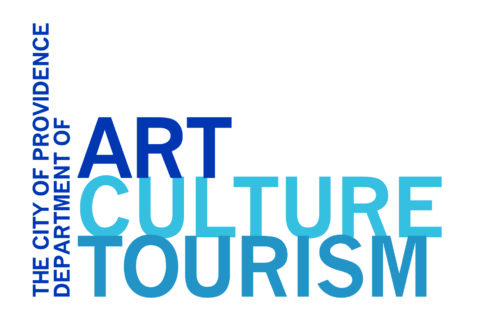
In Recent News
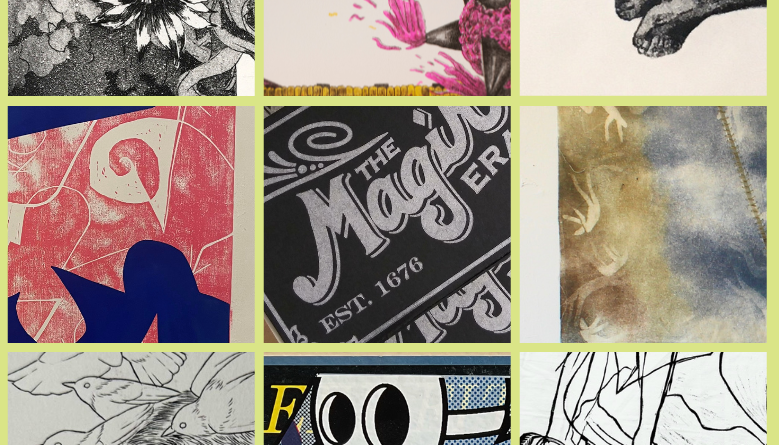
Main Gallery

Call to Artists: Public Art at PVDFest 2024

Nine Artists Awarded Providence Commemoration Lab Commission
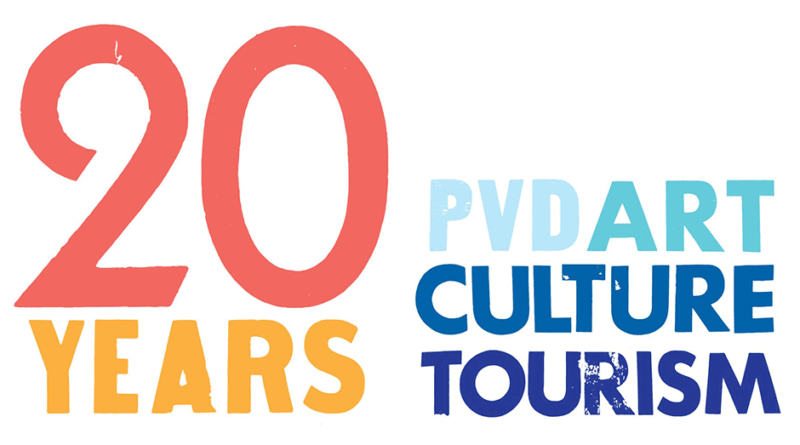
Pell Lecture 2024: Registration
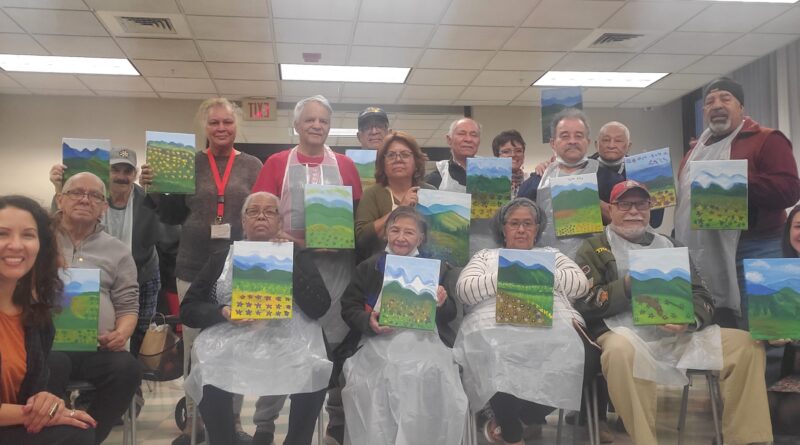
Carolina Briones and Vatic Kuumba announced as artists in residence at Carroll Towers and Chad Brown
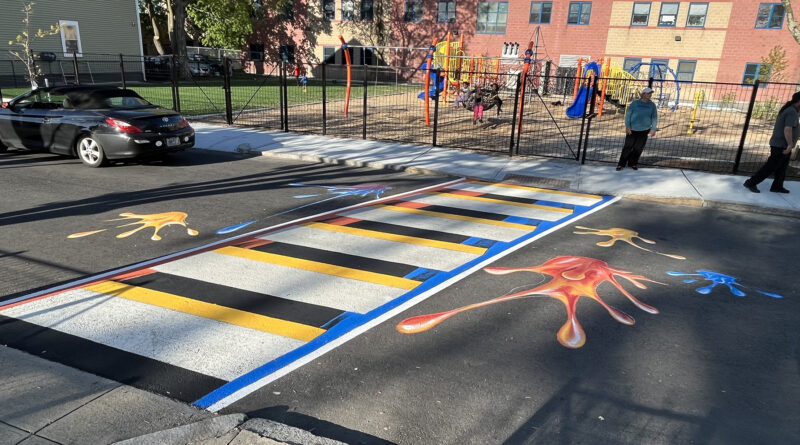
“Pathway to Play” ground mural Installed by Michael and Judi Macaulay
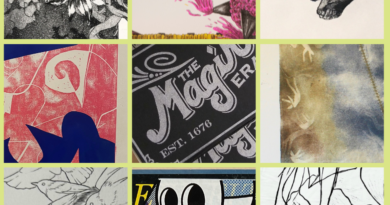
The Main Gallery at Providence City Hall was created to showcase the work of local artists. It is open to

ACT Public Art – Open Calls
Sponsored by act.

Produced in PVD
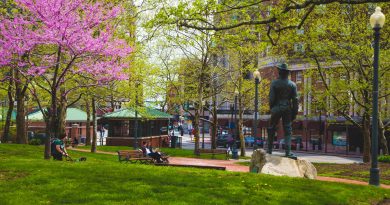
Special Committee for Commemorative Works
The Department of Art, Culture + Tourism is excited to be stewarding the administration of the City’s new Special Committee

“Mi Gente Siempre Responde” Public Art Banners Project

ACT and the Partnership for Providence Parks present POPArt Kits!

PVDFest 2020 Public Artist – Jerold Ehrlich


15 Top-Rated Tourist Attractions & Things to Do in Moscow
Written by Diana Bocco Updated Dec 23, 2023 We may earn a commission from affiliate links ( )
Moscow is one of Europe's most enigmatic destinations, home to a fascinating history and colorful, awe-inspiring architecture you won't find anywhere else in the world. Moscow might be one of the most populous cities in the world with over 11 million inhabitants, but this hasn't changed its strong cultural and social traditions.
Walk the cobblestone streets of the Red Square or the banks of the Moskva River early in the morning, and it's hard to tell what century you're in.
Tsarist architecture, must-see churches, and glamorous shopping opportunities blend together for a visual experience you won't forget. For ideas on what to see and do while visiting Russia, here's our list of top tourist attractions in Moscow.
1. Marvel at the Size of the Kremlin
2. catch a performance at the bolshoi theatre, 3. shop at the luxurious gum, 4. make your way into lenin's mausoleum, 5. spend an hour (or three) at red square, 6. discover history at the museum of cosmonautics, 7. ride the stunning moscow metro, 8. explore the moscow state integrated museum-reserve, 9. spend a rainy day at the tretyakov gallery, 10. walk up and down arbat street, 11. stop by the vdnkh all-russian exhibition centre, 12. wander around gorky park, where to stay in moscow for sightseeing, map of tourist attractions & things to do in moscow.
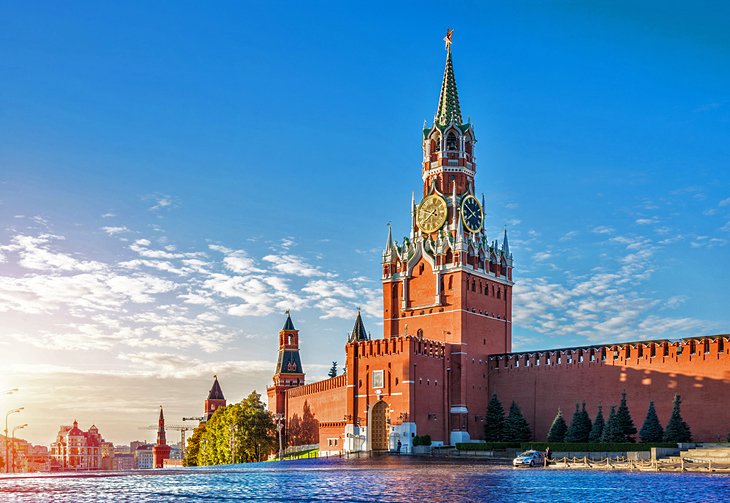
Moscow's most recognizable structure is without a doubt the Kremlin, a 15th-century fortified complex that covers an area of 275,000 square meters surrounded by walls built in the 1400s.
The Grand Kremlin Palace -which has over 700 rooms- was once home to the Tsar family and is now the official residence of the president of the Russian Federation, although most heads of state choose to reside elsewhere.
The massive complex also includes many other buildings, some of which are open to the public and can be visited regularly. Aside from three cathedrals (including one where the Tsars were once crowned) and a number of towers, the Kremlin is also home to the Armory building, a museum holding everything from the royal crown and imperial carriages to the ivory throne of Ivan the Terrible and Fabergé eggs.
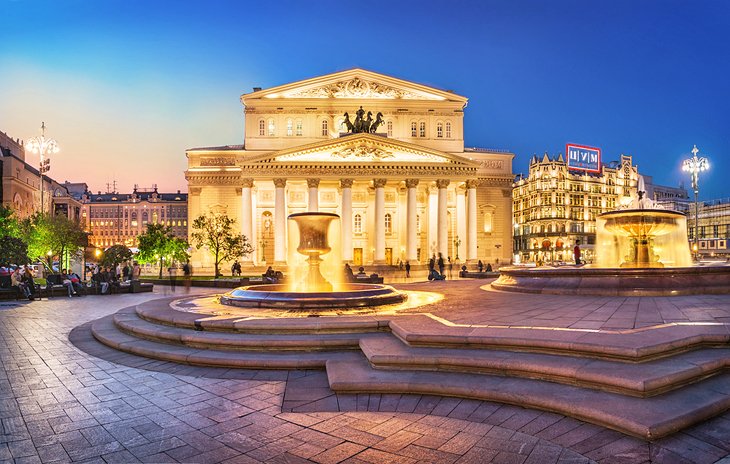
The Bolshoi Theater is home to the largest and one of the oldest ballet and opera companies in the world . While the theater has undergone several major renovations over the past century-including a recent one in 2011 to restore some of the imperial architectural details-it still retains all of its Neoclassical grandeur.
The Bolshoi Theater you see today opened in 1824, after several older versions burned down. Inside, red velvet, a three-tiered crystal chandelier, and gilt moldings give the place a Byzantine-Renassaince grandiose feel like no other.
Catching a show from the resident ballet and opera troupes is a treat, as the theater often presents a number of classic performances, such as Tchaikovsky's Mazeppa and Rachmaninoff's Francesca da Rimini, both of which originally premiered here.
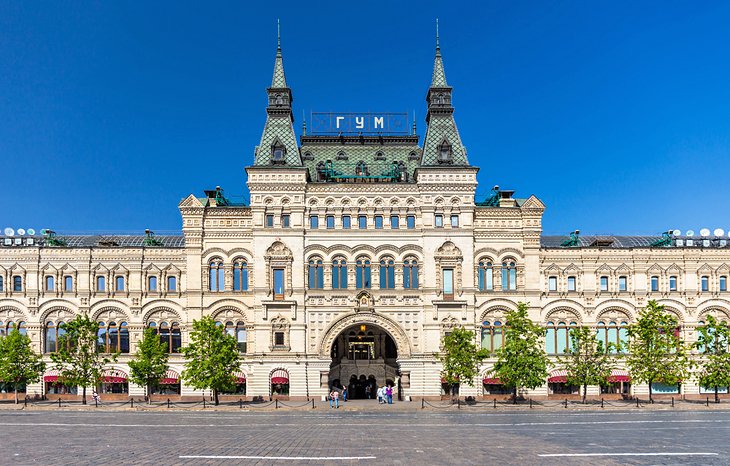
Moscow's oldest and most upscale shopping center is an architectural marvel. GUM (short for Glávnyj Universálnyj Magazín or "Main Universal Store") was built in the late 1800s in neo-Russian style to showcase a beautiful mix of a steel skeleton and 20,000 panels of glass forming an arched roof.
This was a unique construction at the time, since the glass had to be strong enough to support the snow-heavy Russian winters. The building is just as impressive outside, with all three levels covered in marble and granite.
While GUM is no longer the largest shopping center in Moscow, it's still by far the most beautiful. Home to brands like Gucci and Manolo Blahnik, this might not be the ideal destination for most budget-conscious visitors, but the beauty of the building itself is worth a visit.
On the third floor, there are also great dining options, including a Soviet-style canteen that serves traditional Russian food, and a stand selling ice cream made by hand using an original 1954 recipe originally approved by the Soviet government.
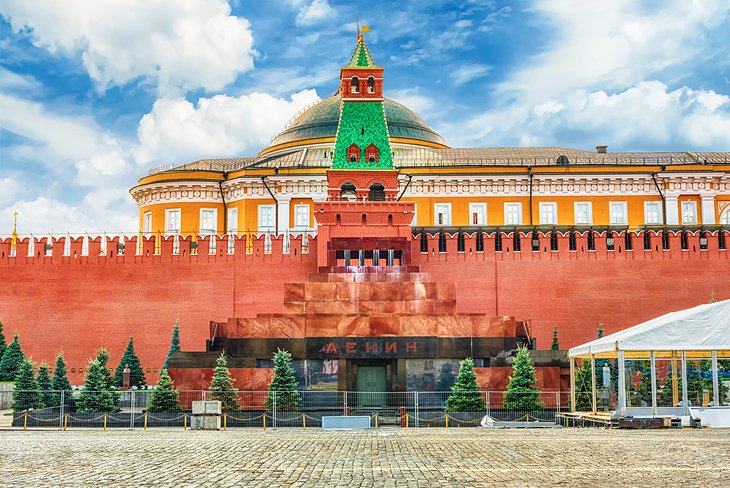
Lenin's Mausoleum, the final resting place of Soviet leader Vladimir Lenin, occupies a central spot in Red Square. His body has been in the mausoleum since his death in 1924-and although the original plan was for him to be buried after a short period of public display for mourning, the plan quickly changed.
After over 100,000 visited the tomb over a period of six weeks, it was decided that a new sarcophagus and a more permanent display space could actually preserve Lenin's body for much longer than expected-and Lenin's Mausoleum was built.
Over the years, the mausoleum and its marble stairs also became the main spot from where Soviet leaders would watch parades and events happening in Red Square.
Lenin's embalmed body can still be seen today, lying down in a bulletproof glass sarcophagus as if he's sleeping. While a visit to the mausoleum is certainly unusual, it has become a must-do for history buffs looking to understand how Lenin's legacy truly changed the nation. Come ready to wait, though -there are usually lines to get in.
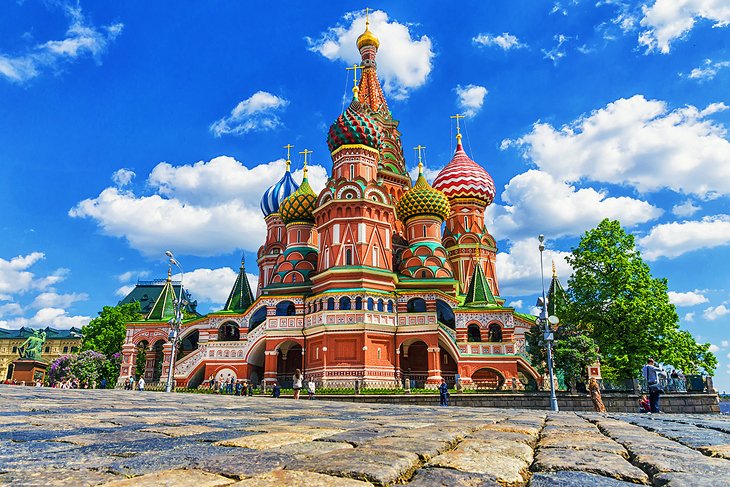
All of Moscow's main streets start at Red Square, so it's easy to see why this is considered the heart of the city. A massive space of 330 meters by 70 meters, the square is flanked by the Kremlin, Lenin's Mausoleum, two cathedrals, and the State Historical Museum.
In 1945, a massive Victory Parade was held here to celebrate the defeat of Nazi Germany by the Soviet Armed Forces.
St. Basil's Cathedral , one of the most recognizable buildings on the square, was built in 1555. The unique cathedral has architectural details inspired by Byzantine and Asian design, as well as details that resemble those found in famous mosques. There are nine individual chapels inside the church, all decorated with colorful mural art.
Both the square itself and the Kremlin are recognized as UNESCO World Heritage Sites . On weekends, there are sometimes stalls selling souvenirs and traditional items here, such as matryoshka (Russian nesting dolls), at the entrance of the square.
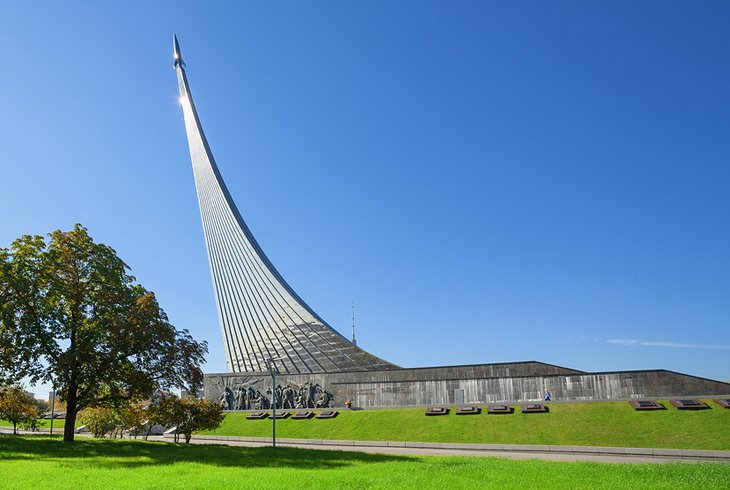
At one point, Russia and the US were toe-to-toe when it came to space exploration. While that might no longer be the case, the museum's amazing collection-which includes over 85,000 items-is still awe-inspiring.
Main exhibits include the space capsule used by Yuri Gagarin , the first human to travel into outer space; a USSR flag with moon fragments; a Soviet spacesuit; and a rocket propulsion unit from the 1960s. A special two-story hall showcases sections of the Mir space station interior, and there are also models of the first sputniks and a replica miniature spaceship.
English-language tours are available, and there's also a Cinema Hall showing subtitled short films about the history of space exploration programs and the first manned space flight.
The museum is located inside the base of the monument to the Conquerors of Space, which was built almost 20 years before the museum opened.
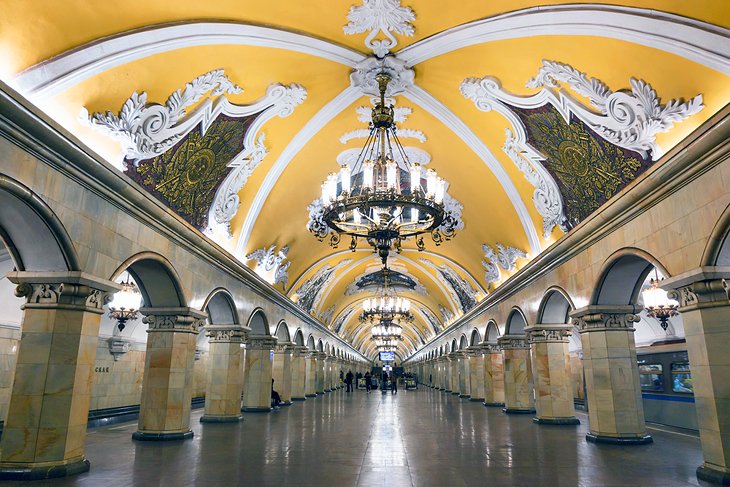
Riding the Moscow metro is an experience all in itself, but even just heading underground to walk through the stations is something no visitor should miss. With 223 stations and 12 metro lines crosscutting through Moscow, however, this can be tricky, so visiting at least a few of the most impressive ones is a good start.
Arbatskaya station was designed by a skyscraper architect, so it's no surprise that it features multicolored granite slabs and impressive bronze chandeliers.
Park Kultury station , located next to Gorky Park, is covered in marble and features reliefs of people involved in sports, while Teatralnaya station is decorated with porcelain figures dancing and wearing traditional Russian costumes.
The metro is open between 5:30am and 1:00am but it's very crowded in the early morning and after 4pm, so it's better to visit in the late morning or early afternoon to really appreciate the architecture without the crowds.
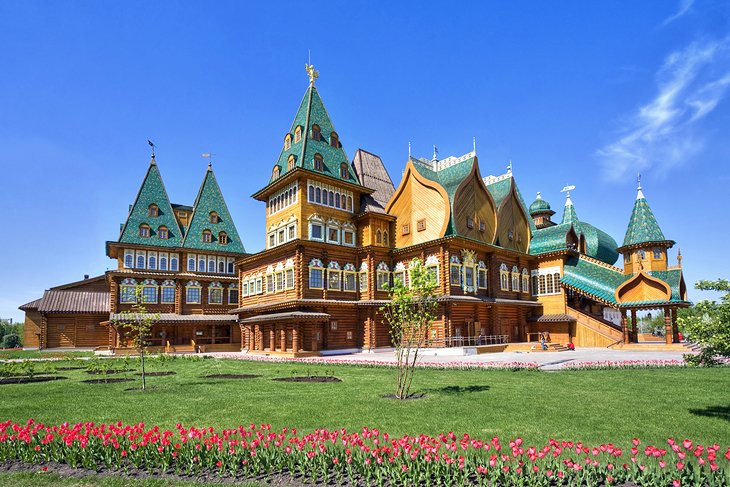
The Moscow State Integrated Art and Historical Architectural and Natural Landscape Museum-Reserve is a cultural open-air museum complex comprised of four different historical sites.
The most important site, the Kolomenskoye Estate, was once the summer residence of Tsars as far back as the 14 th century. The complex, which covers almost 300 hectares, is home to fairy-tale wooden palaces; a tent-roof stone church built in the 1500s; a water tower; fort towers and structures; and the 24-room Museum of Wooden Architecture , which includes the restored dining room of Tsar Alexei I.
Beautiful manicured gardens , riverside picnic areas, and a massive collection of both artifacts and structures make this a great destination to help you see what medieval Russia looked like. English-language tours are available, but you're also free to wander the grounds on your own.
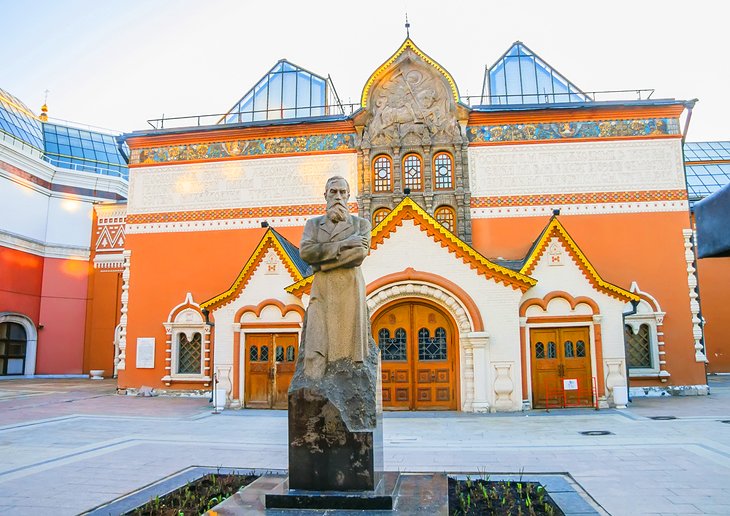
The largest collection of Russian art in the world sits here, with over 180,000 paintings, sculptures, and religious art dating back to over a millennia ago. The gallery, built using beautiful red and white colors from classical Russian architecture, is located near the Kremlin and it was built in the early 20 th century.
Significant art pieces include the Vladimir Mother of God; a Byzantine icon of the Virgin and child dating back to the 1100s; Andrei Rublev's The Trinity icon from the 15 th century; and several works by Ilya Repin, the most famous realist painter in Russia.
On the grounds of the museum, there is also an 86-meter-tall statue of Peter the Great, as well as a number of Socialist Realism sculptures.
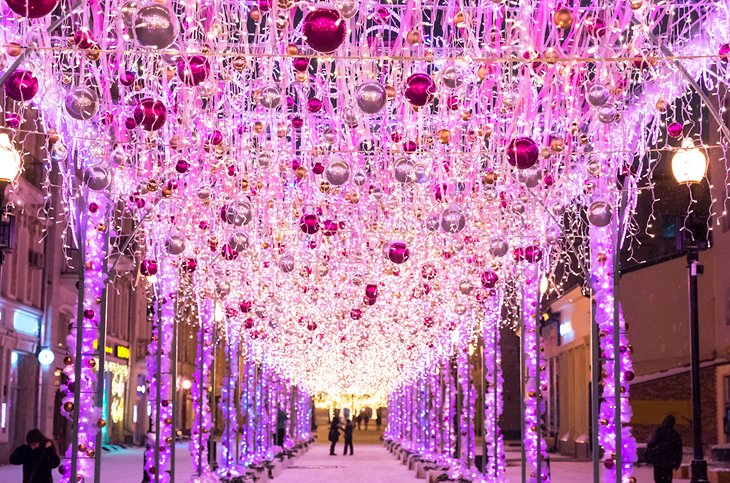
Moscow's one-kilometer-long pedestrian street has been around since the 15 th century. Originally a trade route in the outskirts of the city, Arbat Street is now very centrally located, home to posh buildings and lots of places to eat and shop.
Beautiful street lamps and two significant statues-one of Princess Turandot (from Puccini's last opera) and one of Soviet-era poet Bulat Okudzhava-adorn the street, which fills up with both locals and tourists on evenings and weekends.
A great place to pick up souvenirs or sit down at an outdoor café, Arbat Street also offers a chance to visit the former home of poet Alexander Pushkin and the café both Anton Chekhov and Leo Tolstoy used to visit.
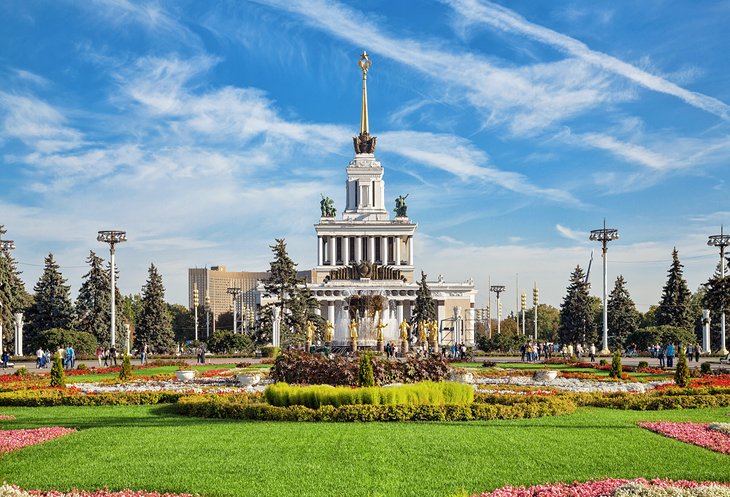
Although it was originally designed as a general-purpose trade show venue, this park complex now houses amusement rides , ice rinks , and a number of galleries and other attractions for all ages.
The park's most famous landmarks are the Moskvarium, a marine biology center home to over 8000 species of marine animals, the Garage Museum of Contemporary Art, and a shopping center selling traditional products from former Soviet countries.
There's even a film museum showing Soviet cartoons or even a full-length film (for an extra fee) and an education center offering masterclasses on everything from becoming a barista to video montage (call or write in advance to find out which ones are English-friendly).
Soviet-era pavilions, sculptures, and fountains abound here as well, including the famous Friendship of the Peoples Fountain, which features statues of women dressed in costumes from different former Soviet countries.
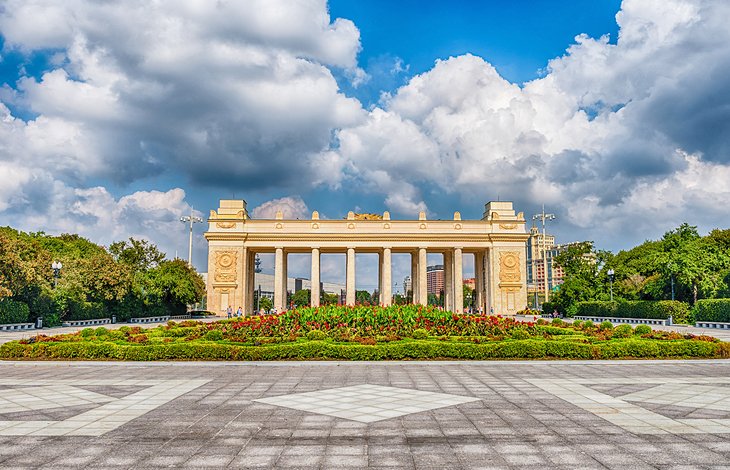
Named after the famous Russian writer Maxim Gorky (who was nominated for the Nobel Prize in Literature five times but never won it) and sitting right across the Moskva River, Gorky Park covers 120 hectares of beautiful ponds and green spaces.
Popular with both locals and tourists, the park offers a variety of things to enjoy-from sunbeds, hammocks, and drinking fountains to free yoga classes and children's playgrounds. There's free Wi-Fi and sockets for charging your phone, as well as many food stands and plenty of wild animals, including deer, rabbits, and pheasants.
Visitors can rent paddle boats and bicycles to explore the park-and from May to October, there is also an open-air movie theater, as well as scheduled presentations by street performers, musicians, and artists. Gorky Park attracts the young and old, so don't be surprised to see a mix of people exercising, playing chess, and sunbathing.
Luxury Hotels :
- Lotte Hotel Moscow is one of the top 5-star properties in Moscow offering the largest Royal Suite in Russia. The trendy rooms and suites here all have contemporary style and great city views. On-site amenities are plentiful. There are two restaurants: one serving contemporary Italian fare, and the other Japanese. There is an impressively lit indoor swimming pool, a well-known spa, and a state-of-the-art gym.
- Another excellent luxury hotel is the Ararat Park Hyatt Moscow . The residential-style property is in the heart of Moscow just next to the Bolshoi Theatre and within walking distance of the Kremlin and Red Square. The rooms and suites have been opulently designed by Tony Chi. The on-site restaurant serves a mix of European and Armenian specialities. There is also a Japanese sushi bar and a rooftop lounge with fabulous city views.
- The St. Regis Moscow Nikolskaya also has a central location just a few minutes from the Kremlin and Red Square. The 5-star property has a mix of elegant rooms and suites, including interconnecting room options for families with kids. There are multiple restaurants on-site including an Italian bistro. Other amenities include the fabulous Iridium Spa, which does a full range of treatments and has an indoor swimming pool, sauna, and steam room.
Mid-Range Hotels :
- Palmira Business Club is a top mid-range choice. The contemporary lifestyle hotel offers well-appointed rooms and suites, including options for families. Suites are quite spacious and have kitchenettes. Amenities here include a complimentary breakfast at the on-site restaurant, a hot tub, sauna, and spa. There is also a fitness center.
- The trendy Mercure Moscow Baumanskaya offers a mix of rooms and suites with contemporary decor. The mid-range hotel can arrange airport transportation and offers baggage storage. Other amenities include a restaurant and room service. The front desk is open 24 hours.
- Boutique Hotel Brighton is about 10 minutes from the city center in a leafy park area. It offers excellent value for money and has charming rooms and suites with sound-proof windows and doors, as well as blackout curtains. A complimentary breakfast is served, and there is also an indoor swimming pool.
Budget Hotels :
- Hotel Ibis Budget Moscow Panfilovskaya is about a 15-minute drive from Moscow's downtown, and it's within walking distance from a metro station that will take you there. The soundproof rooms at this budget property are clean, comfortable, and can sleep up to three people. The hotel is pet friendly, has paid parking available on-site, and also has a salon.
- If you just need a budget hotel near the airport then check out Aviator Hotel Sheremetyevo . Located right at the airport, it has soundproof rooms, including options for families. Amenities include an indoor play area for kids, a sauna and swimming pool, and a free breakfast.
More Related Articles on PlanetWare.com
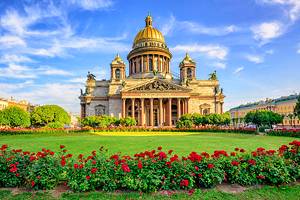
Exploring Russia: Whether you are interested in history, nature, or architecture, there's much to see in Russia. For a good introduction to some of the most fascinating spots in the country, take a look at our article on the Best Places to Visit in Russia . For more on Russia's second-largest city and all it has to offer, check out our piece on the Top-Rated Tourist Attractions in St. Petersburg .

- Icon Link Plus Icon
Venice Residents Protest New Entry Fee to the City
By Daniel Cassady
Daniel Cassady
Senior Writer, ARTnews

A week after the Venice Biennale opens to thousands of art world VIPs, journalists, curators, and arts workers, the city has launched a fee program aimed at curbing the effects of “excessive tourism” that will require visitors and tourists to pay a €5 (about $5.36) in order to enter the city, the Guardian reports.
Related Articles
Indigenous artists take venice biennale's top prizes as mataaho collective, archie moore win big, in the venice biennale's historical sections, overlooked 20th-century figures come into focus.
“I can tell you that almost the entire city is against it,” Matteo Secchi, who leads Venessia.com, a residents’ activist group, told the Guardian. “You can’t impose an entrance fee to a city; all they’re doing is transforming it into a theme park. This is a bad image for Venice … I mean, are we joking?”
The fee will be mandatory only for access to Venice’s historic center and will only be in effect for 29 days, mostly weekends, from Thursday April 25 through July 14. Residence, overnight visitors, students, and children under 14 are exempt from the entry fee.
Tickets are purchasable online and random checkpoints have been established across five of the city’s main points of entry, including the train station at Santa Lucia. No ticket? Expect a fine of between €30 and €500.
According to the Venice council 5,500 people booked a ticket for the April 25, which happens to be an Italian national holiday. Brugnaro denies the plan is merely a money-making scheme, though the city did earn €27,000 on the first day. Should the plan prove successful, the mayor says he would implement a tax cut for residents.
The 60th Venice Biennale , titled “ Strangers Everywhere ” and curated by the Brazilian artistic director of the Museu de Arte de São Paulo, Adriano Pedrosa, officially opened on April 20 and will run through November 24. The last edition of the Biennale, in 2022, drew 880,000 visitors into the city despite Covid-related travel restrictions, a record for the international exhibition.
Martin Short Just Bought a Secluded L.A. Home
How grace kelly’s look-alike granddaughter camille gottlieb takes after her in philanthropy, style and jewelry, leak says deadpool 3 has a ‘mind-blowing’ post-credits scene, ncaa names nil registry partner after five-year process, the best yoga mats for any practice, according to instructors.
ARTnews is a part of Penske Media Corporation. © 2024 Art Media, LLC. All Rights Reserved.

Touropia Travel Experts
Discover the World
17 Top Tourist Attractions in Moscow

The capital of Russia is an incredible place to explore. Visitors to Moscow come away spellbound at all the amazing sights, impressed at the sheer size and grandeur of the city. Lying at the heart of Moscow, the Red Square and the Kremlin are just two of the must-see tourist attractions; they are the historical, political and spiritual heart of the city – and indeed Russia itself.
A fascinating city to wander around, stunning cathedrals, churches, and palaces lie side-by-side with bleak grey monuments and remains from the Soviet state. In addition to its plethora of historical and cultural tourist attractions, Moscow is home to world-class museums, theaters and art galleries.
Renowned for its performing arts, fantastic ballets and amazing circus acts, catching a show while in Moscow is a must. The wealth of brilliant restaurants, trendy bars, and lively nightlife means there is something for everyone to enjoy.
See also: Where to Stay in Moscow
17. Tsaritsyno Palace
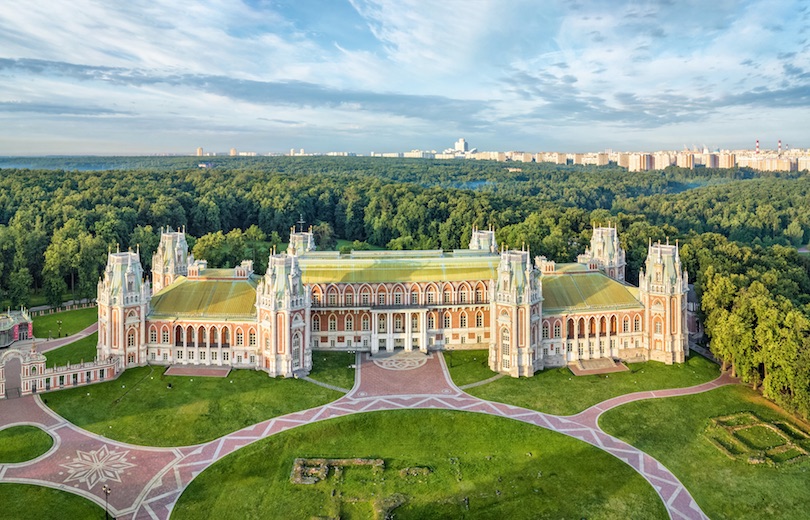
Once the summer residence of Catherine the Great, the stunning Tsaritsyno Palace is now a museum-reserve. The architecture is magnificent and there is a lovely park surrounding it for visitors to explore.
Located in the south of Moscow, the palace was commissioned in 1775 and recent renovations mean its lavish interior looks better than ever before with its elegant halls and beautiful staircases.
The exhibits on display look at the life of the empress as well as the history of Tsaritsyno itself. The huge palace grounds are also home to some other delightful buildings with the elegant opera house and wonderful brickwork of the Small Palace being particularly impressive to gaze upon.
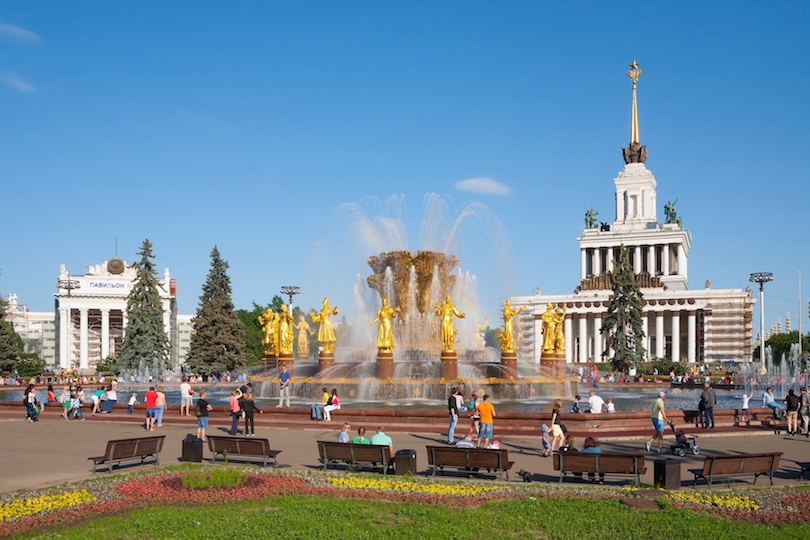
Starting out in 1935 as the ‘All-Union Agricultural Exhibition’, VDNKh has slowly morphed over the years into the fascinating open-air museum of today. Remarkably, over 400 buildings can now be found within its confines.
The huge park complex has numerous pavilions representing former Soviet republics on show, such as those of Armenia and Turkmenistan and the distinctive architecture of each of the buildings is always interesting to gaze upon. In addition to this there is the fascinating Memorial Museum of Cosmonautics which is dedicated to space exploration and the fun Moskvarium aquarium even offers you the chance to swim with dolphins.
With lots of eateries scattered about and numerous entertainment options such as horse-riding and zip-lining, there is something for everyone to enjoy; the Friendship of Nations fountain truly is wonderful.
15. Kremlin Armoury
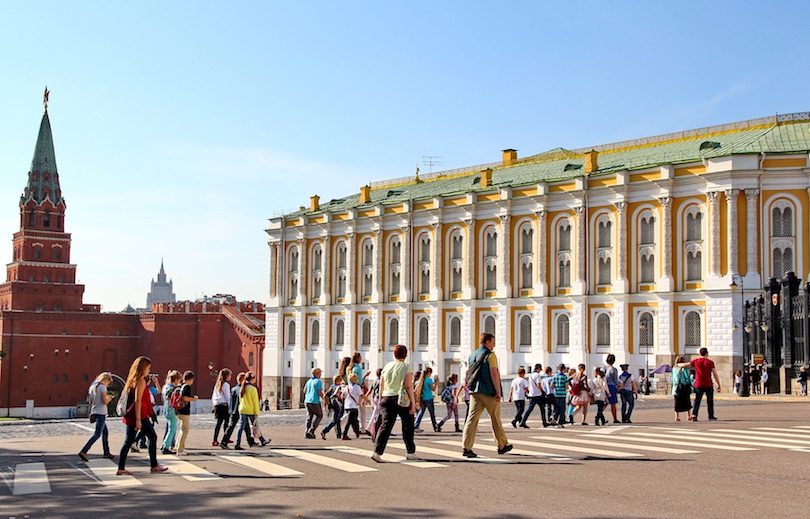
One of the oldest museums in the city, the Kremlin Armoury has a wealth of treasures; highlights include the ornate Grand Siberian Railway egg, the historic Cap of Monomakh and the stunning Imperial Crown of Russia which often has a crowd of tourists around it, jostling to take a photo.
Once the royal armory, there are loads of fascinating objects on display. Perusing the many sabers, jewelry, armor and more is as interesting as it is educational and entertaining and the swords are so finely crafted that you’ll almost wish you could pick up one and wield if yourself.
Established in 1851, the museum is situated in the Moscow Kremlin.
14. GUM Department Store

Standing for ‘Main Universal Store’ in Russian, GUM is stunning. Its wonderful skylights and beautiful facades mean it doesn’t look out of place alongside its illustrious neighbors on Red Square.
With over 200 shops, boutiques and upmarket eateries inside, it is a shopaholic’s heaven and concerned partners will be glad to find more affordable options alongside luxury brands such as Dior and Prada.
The main department store in the city, GUM was opened in 1893. The stunning architecture makes it well worth a visit even if shopping isn’t your thing.
13. Moscow Metro
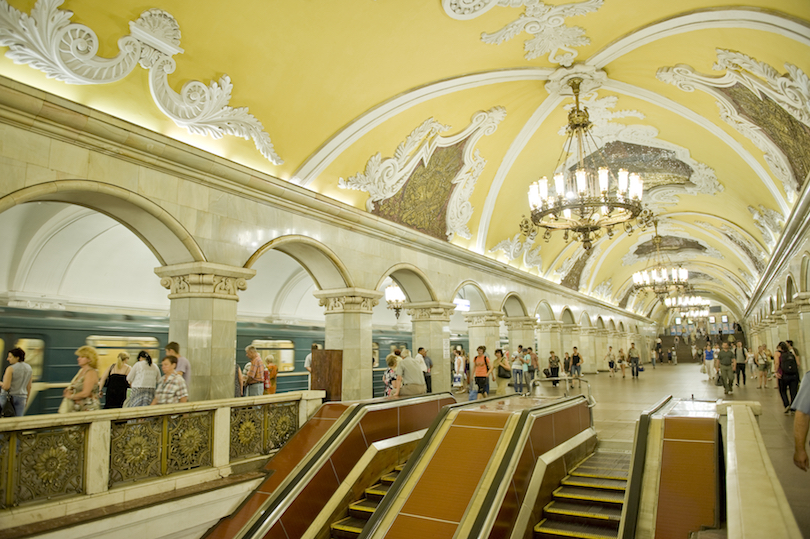
It’s not often that public transport looks like a work of art. So many stops on the Moscow Metro will astound visitors with their beauty and elegance.
Decked in marble and with frescoes covering the walls, the stations are amazing to gaze upon and are part of one of the longest metro systems in the world, with the first stations opened in 1935.
Using the metro is the quickest and easiest way to get around Moscow and braving the crowds of commuters is well worth it for the beauty all around you.
12. Arbat Street
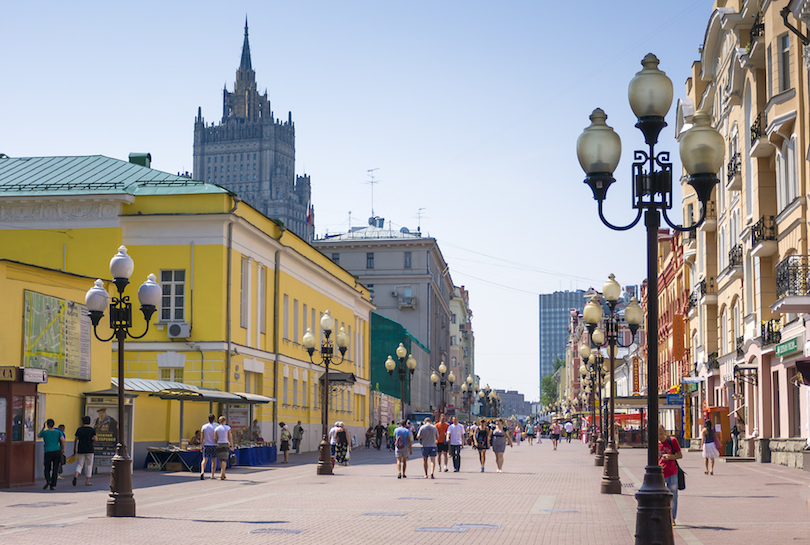
An elegant yet lively street, Arbat is full of impressive architecture and was once a popular place to live for aristocrats, artists, and academics.
A historic place, it is down Arbat Street that Napoleon’s troops are said to have headed on their way to capture the Kremlin.
Nowadays, there are many cafes, restaurants, and shops, as well as various monuments and statues to former residents such as Alexander Pushkin who was reputed to be a lover of the Russian Empress due to his massive influence in court.
11. Novodevichy Convent
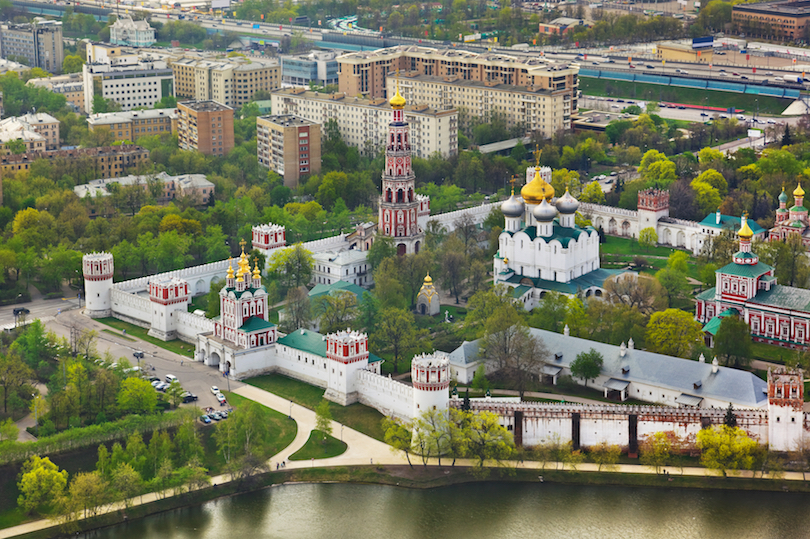
Drenched in history, the Novodevichy Convent is located in a striking building that was once a fortress. This captivating place is well worth visiting when in Moscow.
Founded in 1524, the convent houses four cathedrals; Smolensk Cathedral is the undoubted highlight due to its delightful 16th-century frescoes.
Wandering around the grounds is like stepping back in time. The Novodevichy Cemetery is where many famous leaders of the Soviet Union are buried, such as Yeltsin and Khrushchev.
10. Pushkin Museum
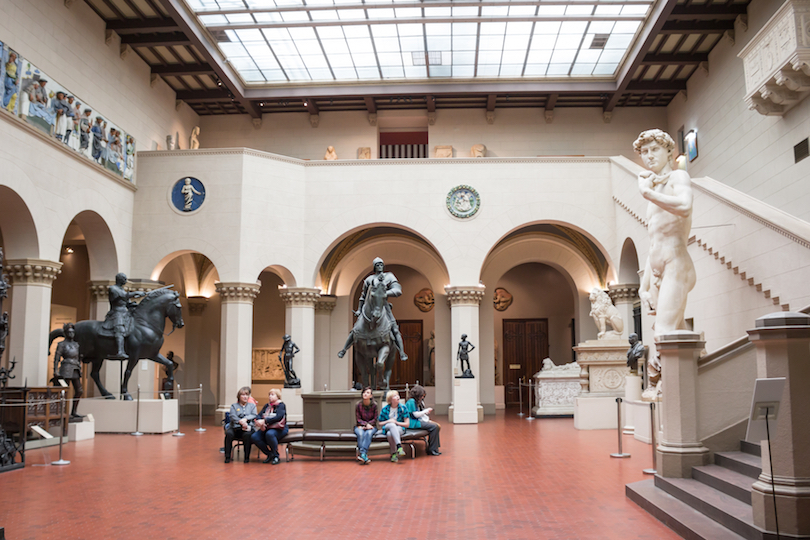
Despite its name, the Pushkin Museum of Fine Arts actually has no connection at all to the famous poet other than that it was named in his honor after his death. A delight to visit, its extensive collection focuses on European art with masterpieces by Botticelli, Rembrandt, and van Gogh all featuring.
Sculptures, graphic art, paintings and more can be found in its beautiful galleries; various sections look at themes and epochs such as the Renaissance, the Dutch Golden Age, and Byzantine art.
Among the many highlights are the clownish characters which can be found in Cezanne’s Fastnacht (Mardi Gras) and the twirling ballerinas who look so elegant in Degas’ Blue Dancers. Picasso’s Young acrobat on a Ball is also well worth checking out for its interesting use of shapes and colors.
9. Christ The Savior Cathedral
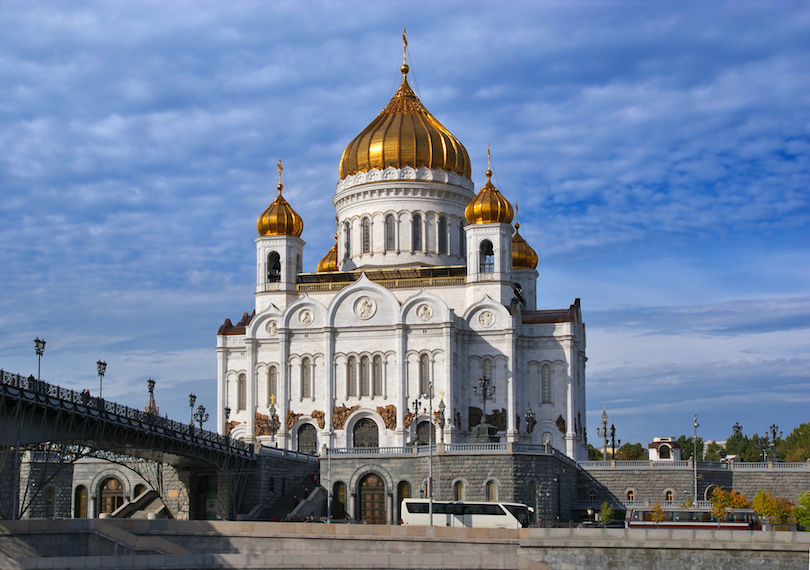
This gorgeous Russian Orthodox cathedral is located on the banks of the Moskva River, just a stone’s throw away from the Kremlin.
The church as it stands today was consecrated in 2000, as the original church that stood here was destroyed on the command of Josef Stalin in 1931 due to the anti-religious campaign.
With its delightful golden dome, spires and dazzling white facades, the Christ the Savior Cathedral is stunning. The interior is just as captivating to wander around, with its beautifully tiled floors and impressive altar.
8. Lenin Mausoleum
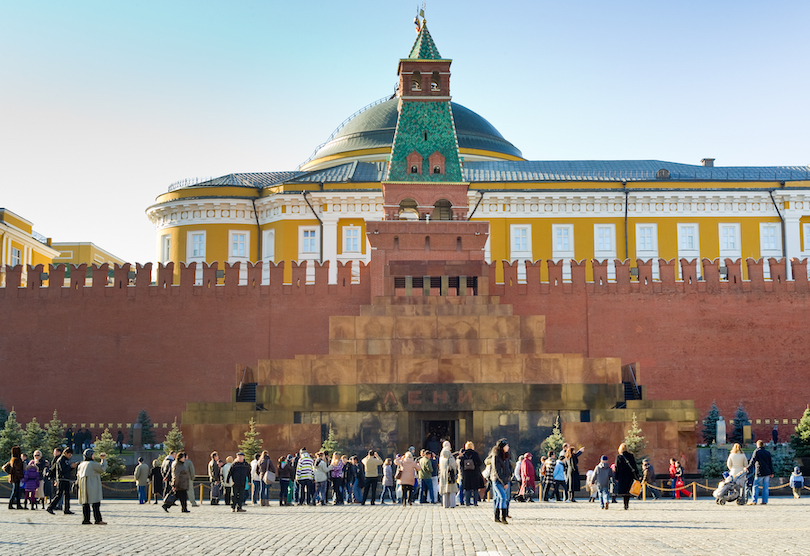
Opened to the public in 1924, Lenin’s Mausoleum is one of the most popular tourist attractions in Moscow. The red granite structure is located at the heart of the city in Red Square.
Lenin’s embalmed body lies in a glass sarcophagus; it is a somewhat eerie experience walking past the former leader of the Soviet Union but is well worth doing as you understandably can’t do it anywhere else in the world.
After visiting the mausoleum, head to the Kremlin wall right next to it for more graves of important communist figures such as Stalin and Brezhnev.
7. Tretyakov Gallery
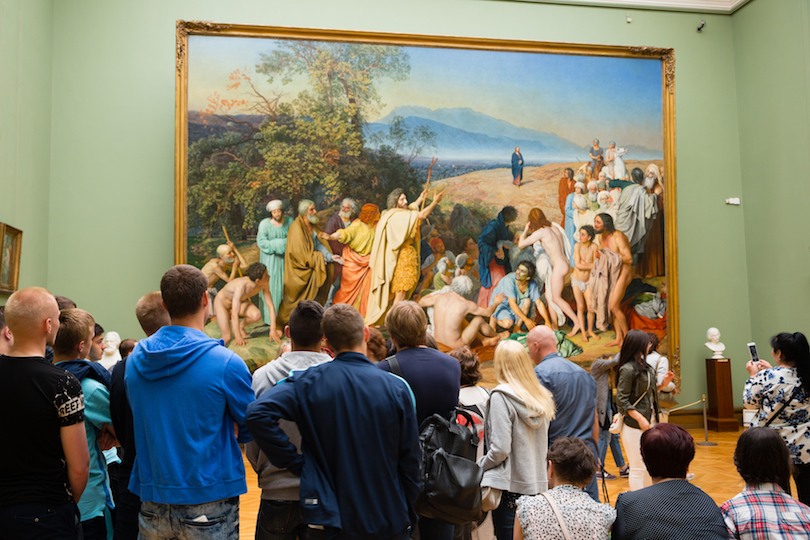
Home to the most extensive and impressive collection of Russian fine art in the world, the State Tretyakov Gallery is definitely worth visiting when in Moscow for the wealth of amazing art pieces that it has on display.
Having started out as the private art collection of the Tretyakov brothers, there are now over 130,000 exhibits. Highlights include the iconic Theotokos of Vladimir which you will almost certainly recognise despite probably not knowing the name and Rublev’s Trinity which is considered to be one of highest achievements in Russian art.
An absolute must for art lovers, the State Tretyakov Gallery will delight visitors with all that is has to offer.
6. Kolomenskoye
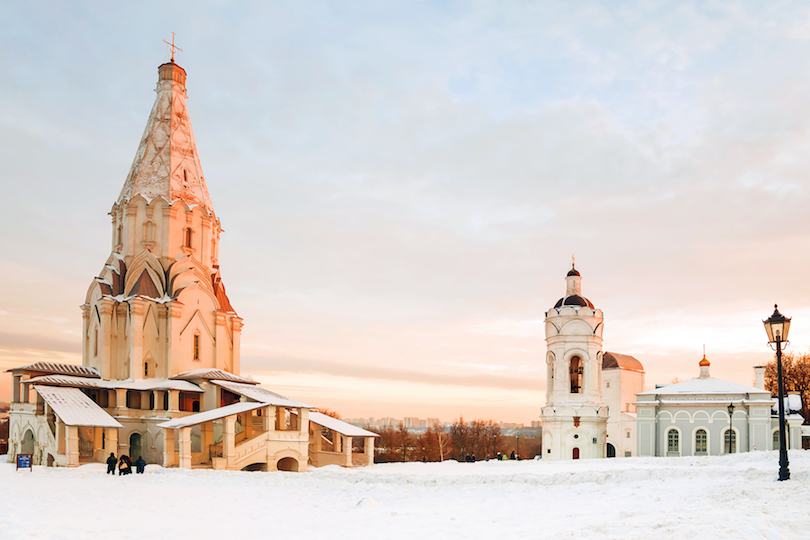
Once a royal estate, Kolomenskoye is now a museum-reserve and lies a few kilometers outside of the city center. A captivating place to visit, there is a plethora of history on show and the site overlooks the Moskva River.
Consisting of four historical sites, there are extensive gardens for visitors to explore, as well as loads of interesting old buildings, the former village of Kolomenskoye itself and the impressive Palace of the Tsar Alexey Mikhailovich – once considered the Eighth Wonder of the World by contemporaries.
Among the many stunning sights, it is the brilliantly white Ascension Church that is the undoubted highlight – dating back to 1532.

5. Gorky Park
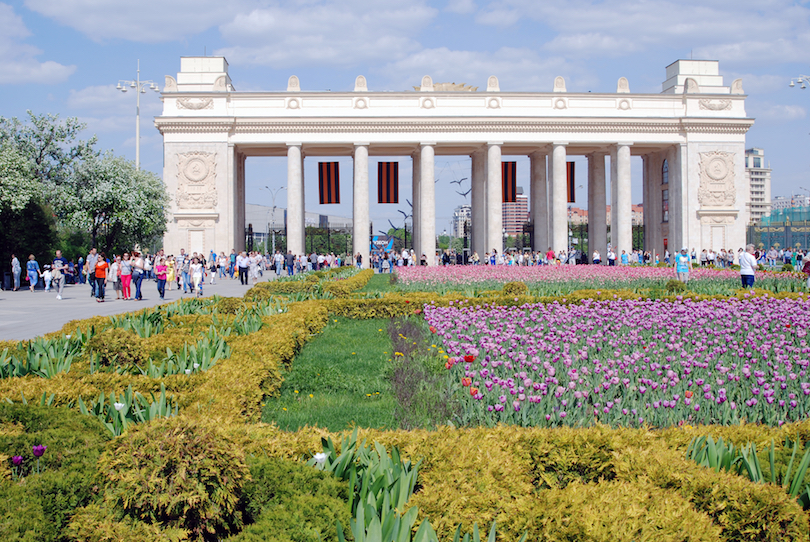
Lying alongside the Moskva River, the huge Gorky Park is a lovely place to visit. Its extensive gardens are home to numerous cultural institutions and visitors should definitely check out the Garage Museum of Contemporary Art and while the eclectic exhibits may not always feature such incredible sights as a balloon-covered rider on a zebra; they certainly always succeed in pushing back the boundaries of art.
Pop-up exhibitions and festivals can be found from time to time in the park itself and there is an open-air theatre and numerous eateries alongside a plethora of leisure activities.
Whether it’s cycling, table tennis or yoga that you are after or beach volleyball and rowing, Gorky Park certainly has it. In winter, there is a huge ice rink for visitors to enjoy.
4. Bolshoi Theatre
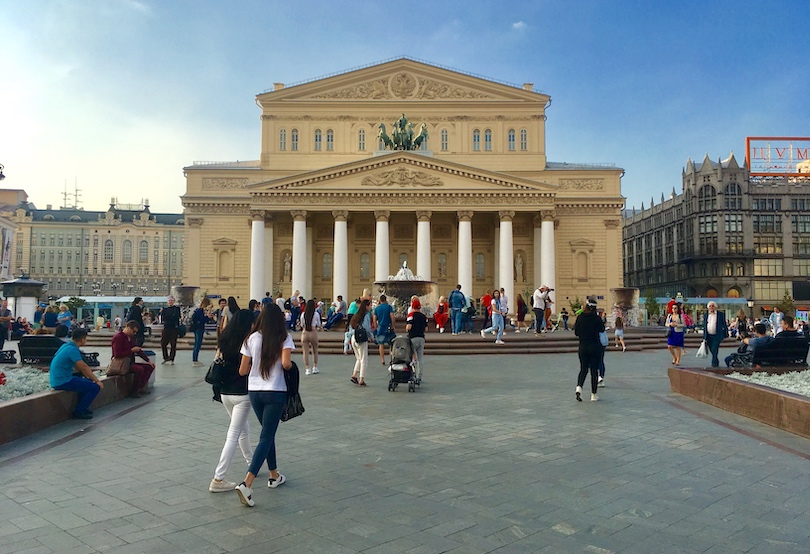
The Bolshoi Theatre is the main theater in the country. The amazing opera and ballet performances it has put on over the centuries go a long way in explaining Russia’s rich history of performing arts.
While the Bolshoi Ballet Company was established in 1776, the theater itself was opened in 1825. The glittering, six-tier auditorium is lavishly and decadently decorated; it is a fitting setting for the world-class performances that take place on its stage.
Spending a night watching a performance of such classics as The Nutcracker or Swan Lake at the Bolshoi Theatre is sure to be a memorable experience and the beauty all around you only adds to the sense of occasion.
3. Moscow Kremlin
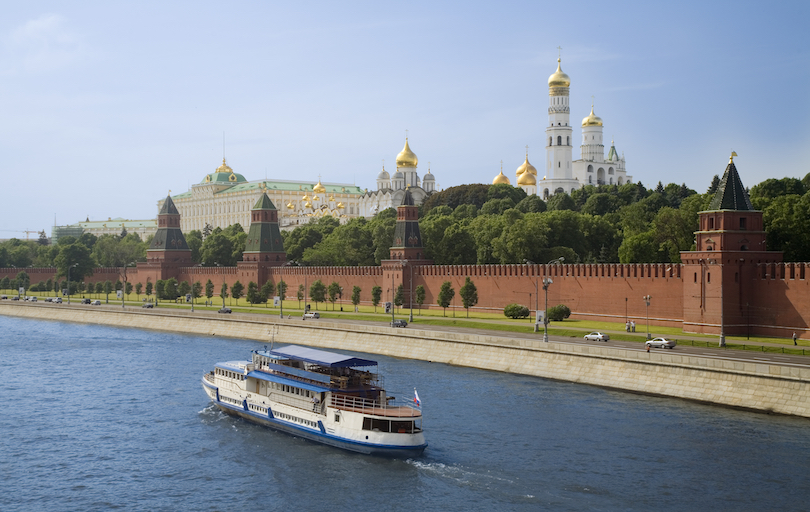
This famously fortified complex is remarkably home to five palaces and four cathedrals and is the historic, political and spiritual center of the city. The Kremlin serves as the residence for the country’s president. It has been used as a fort, and this fact is made clear by its sheer size. The Kremlin’s outer walls were built in the late 1400s.
Under Ivan III, better known as Ivan the Great, the Kremlin became the center of a unified Russian state, and was extensively remodeled. Three of the Kremlin’s cathedrals date to his reign that lasted from 1462-1505. The Deposition Church and the Palace of Facets were also constructed during this time. The Ivan the Great Bell Tower was built in 1508. It is the tallest tower at the Kremlin with a height of 266 feet (81 meters).
Joseph Stalin removed many of the relics from the tsarist regimes. However, the Tsar Bell, the world’s largest bell, and the Tsar Cannon, the largest bombard by caliber in the world, are among the remaining items from that era. The Kremlin Armory is one of Moscow’s oldest museums as it was established more than 200 years ago. Its diamond collection is impressive.
The Kremlin’s gardens – Taynitsky, Grand Kremlin Public and Alexander – are beautiful. The Kremlin has also served as the religious center of the country, and there is a tremendous number of preserved churches and cathedrals here. The collections contained within the museums include more than 60,000 historical, cultural and artistic monuments. Those who enjoy the performing arts will want to consider attending a ballet or concert at the State Kremlin Palace. Completed in 1961, it is the only modern building in the Kremlin.
2. Red Square
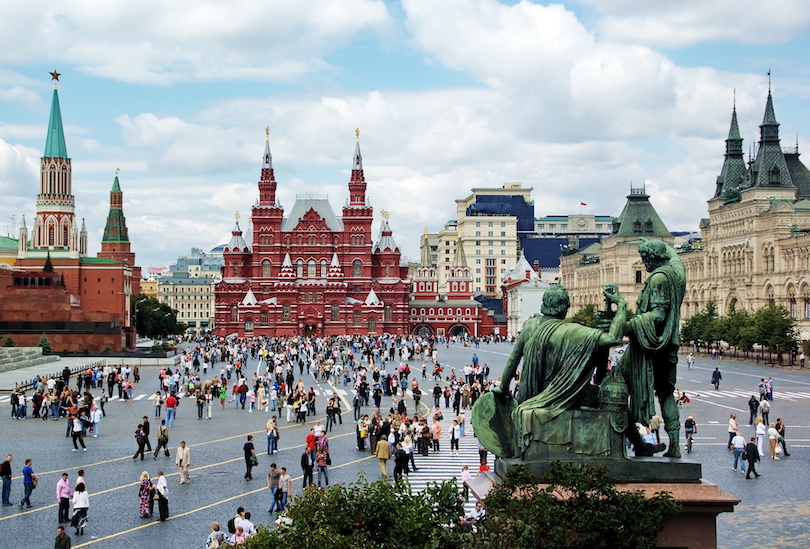
Lying at the heart of Moscow, Red Square is the most important and impressive square in the city. It is one of the most popular tourist attractions due to its wealth of historical sights and cultural landmarks.
Drenched in history, the huge square is home to incredible sights such as the Kremlin, St. Basil’s Cathedral and Lenin’s Mausoleum, among others. Consequently, it is not to be missed when in Moscow as it really is home to the city’s most stunning monuments.
It is here that many important moments in Russian history took place; the former marketplace has hosted everything from Tsar’s coronations and public ceremonies to rock concerts and Soviet military parades. Wandering around the massive square is a humbling experience and undoubtedly one of the highlights the city has to offer.
1. Saint Basil’s Cathedral
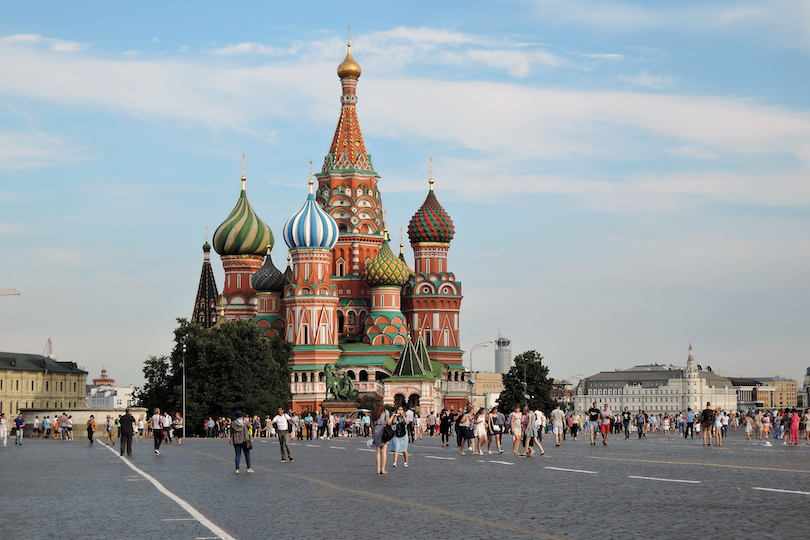
Located in the impressive Red Square, St. Basil’s Cathedral is gorgeous; its delightful spires appear as if out of a fairytale. The most recognizable building in the country, the cathedral is very much a symbol of Russia. No visit to Moscow is complete without having taken in its unique and distinctive features.
Ivan the Terrible ordered the cathedral’s construction in the mid-16th century, and legend holds that Ivan put out the architect’s eyes so that he would be unable to build another cathedral more glorious than St. Basil’s. Designed to resemble the shape of a bonfire in full flame, the architecture is not only unique to the period in which it was built but to any subsequent period. For various reasons, both Napoleon and Stalin wanted to destroy the cathedral but fortunately did not succeed.
Known for its various colors, shapes and geometric patterns, St. Basil’s Cathedral houses nine different chapels that are all connected by a winding labyrinth of corridors and stairways. On the lower floor, St. Basil’s Chapel contains a silver casket bearing the body of St. Basil the Blessed.
Throughout the cathedral are many beautiful murals, frescoes, wooden icons and other art works and artifacts. Outside the cathedral is a lovely garden with the bronze Monument to Minin and Pozharsky, who rallied an all-volunteer Russian army against Polish invaders during a period of the late 16th century known as the Times of Troubles.
Share this post:
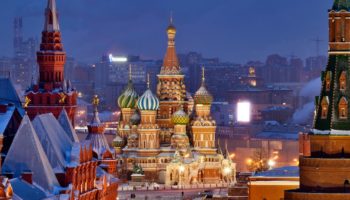
Where to Stay in Moscow
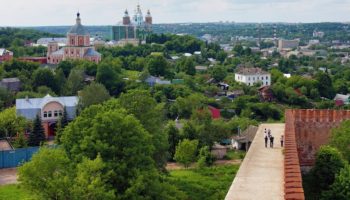
15 Best Cities to Visit in Russia
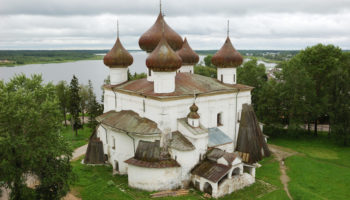
14 Most Scenic Small Towns In Russia
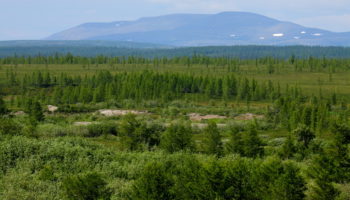
9 Most Beautiful Regions in Russia
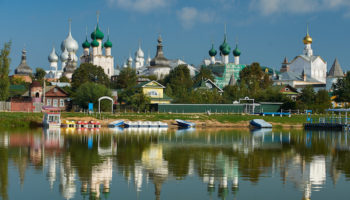
10 Best Places to Visit in Russia
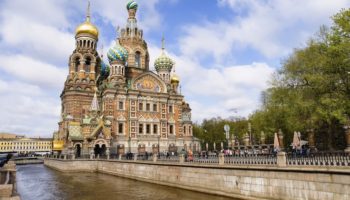
15 Best Attractions & Things to do in Saint Petersburg, Russia
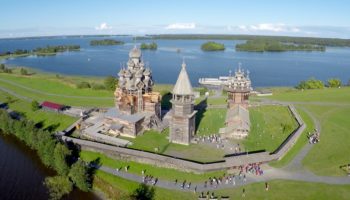
10 Top Tourist Attractions in Russia
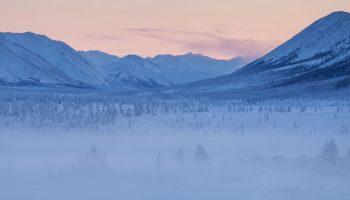
10 Most Amazing Destinations in Eastern Russia
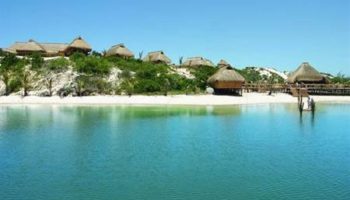
8 Best Mozambique Beach Resorts

8 Most Beautiful Society Islands
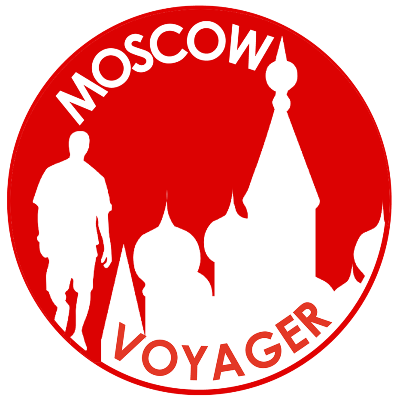
Moscow’s Top 13 – The Main Attractions of the Russian capital

13 Moscow Attractions
One of the most fascinating metropolis, breathtaking city, and a vibrant European capital, Moscow is a powerful mix of history and edginess, full of world famous sites and attractions that are worth exploring. However, it would take weeks to really explore all facets of the Russian capital – unfortunately hardly any traveler has that much time, which is why you should concentrate on the absolute Moscow top attractions and highlights. Here is the list of top 13 Moscow attractions you can choose on your next Russian travel journey.
What Times Square means to New York, Pariser Platz with the Brandenburg Gate to Berlin, or Trafalgar Square to London – Red Square means to Moscow. The heart of Russia’s capital it is the central meeting point and the most famous photo opportunity. No place stands for Russia and Moscow more than “krasnaja ploshchad”, as Red Square is called in Russian.
It is arguably one of the Moscow main attractions and most visited. With the gigantic military parade on Victory Day in World War II, which takes place every year on May 9, the pictures of the square go around the world year after year. But for the rest of the year you will mainly meet local and foreign tourists here, who take peaceful pictures and soak up the unique spirit. The square looks spectacular illuminated at night, but you should visit the square at least once in daylight as well.

If you stand in the middle of the huge cobblestone square, in the clockwise direction you can see the Kremlin and the Kremlin Wall with a total of 20 individually designed towers, Lenin’s Mausoleum, Historical Museum built with red bricks, the little Kazan Cathedral, the impressive luxury department store GUM, the imposing St. Basil’s Cathedral and, the bridge over the Moskva River. This unique ensemble offers more sightseeing highlights at one stroke than any other tourist attractions in Moscow or the world.
So it’s no wonder that Red Square is UNESCO World Heritage Site and offers the most popular photo opportunities worldwide. When visiting Moscow, there is no reason not to visit to Red Square and a selfie is practically also a must – getting there is easy even for Russia newcomers. Although Red Square does not have its own metro station, it is still child’s play to find the way there – especially since the Square is the absolute geographical center of the city.
There are four metro stations in the vicinity, from which it is only a short walk to Red Square, Okhotny Ryad and Teatralnaya directly at the northwest entrance of the Square at the Historical Museum; further to the west is the Lenin Library station, from which one arrives at the same entrance through the Alexander Garden. As well as the station Revolution-square behind the GUM department store, which leads past to the northeast side of the Square.
The Kremlin
This is the biggest active fortress in Europe offering a week’s worth of attractions. For more than 70 years, the Kremlin was the power center of the Soviet Union, which the US President Ronald Reagan called the Empire of Evil exactly 35 years ago, one of the symbols of the East-West conflict in the Cold War. People in the West feared the «dark» plans that were built behind the thick walls of the Kremlin.
The Kremlin is built in a triangular shape on the natural elevation above the Moscow River, known today as the Kremlin Hill. Today’s metropolis Moscow has expanded in a circle around it and the road around the Kremlin is considered the first of several ring roads in Moscow counting.
Now Kremlin has lost its terrifying image, although it is still the seat of the Russian President and thus one of the most important places in World political events. It is an inviting, historical sight for tourists, and one of the famous Moscow tourist attractions which can be visited for just a few dollars.
The large parts of the 28 hectare site can be visited by tourists – with the exception of the Kremlin towers, the presidential Grand Kremlin Palace and the Senate Palace. The first port of call on the site is the so-called Cathedral Square, which is the geographical center of the Kremlin and at the same time the highest point on the Kremlin Hill and contains the three oldest structures in the complex. The three 15 th -century cathedrals of the Kremlin (the Dormition, Archangel Michael and the Annunciation Cathedrals), which together with the Ivan the Great Bell Tower and the Cathedral of the Deposition of Mary, make the most famous ensemble of the Kremlin. Also to be visited here are primarily the Armoury and the Patriarch’s palace.
To get to the Kremlin, you have to pass a security gate at one of the two publicly accessible entrances – these are located at the Kutafja and Borovitsky towers. Tickets cost from 700 rubles upwards, the admission to the Armoury, the Ivan the Great bell tower and the Patriarch’s Palace being paid for separately.
More about the Kremlin
Lenin’s Mausoleum
This is the ultimate love it or hate it tourist attractions in Moscow It may be mistaken for a gloomy performance, but Lenin remains an absolute attraction almost a hundred years after Vladimir Lenin death. The founding father of the Soviet Union is not only a fascinating historical figure of world renown for supporters of communism. Despite ongoing discussions about a final burial of the leader of the communist October Revolution in 1918, hundreds of thousands come year after year to the dark marble building on Red Square, right next to the Kremlin wall, to see the embalmed body of the legendary Russian revolutionary.
First opened to the public in 1924, the Mausoleum attracts 2.5 million visitors every year, so, visitors have to wait a long time to get into the illustrious building. Also, photos from inside the Mausoleum are prohibited. But a visit is still a must for Moscow visitors, especially since the visit is free. Please note that the Mausoleum is only open on Tuesdays, Wednesdays, Thursdays and Sundays from 9 a.m. to 1 p.m.
The queue starts behind the Historical Museum and before you get into the actual mausoleum, you have to pass an airport-like security gate – cameras and cell phones are not allowed into the Mausoleum, but can be safely placed in a cloakroom for a small fee. On the way out of the Mausoleum, after the visit, you pass the graves of the other Soviet heads of state. Including the grave of Josef Stalin, who was briefly kept next to Lenin in the Mausoleum after his death. But in the course of de-Stalinization, the cruel dictator was moved to the less prominent place behind the Mausoleum.
More about the Lenin Mausoleum
The Alexander Garden (Alexandrovsky Sad)
If you visit Moscow in summer, the hustle and bustle in the metropolis of millions can get over your head. The city, best known for its icy winters, can turn into an absolute burning furnace in summer. It sometimes takes over an hour to get to the edge of the metropolis. The perfect retreat, located in the center of Moscow, is therefore the Alexander Garden and one of the Moscow top attractions.
Located directly on the western wall of the Kremlin, the Alexander Garden is just a small, but all the more well-kept park that extends to the nearby Manege Square (Manezhnaya Ploschad). The garden undergoes a lot of changes, with old trees cut down in 2012 and over 200 planted, the authorities also claim that there will be a rosary of 3000 roses. As soon as the first rays of sun warm up the Muscovites, tormented by the long winter, they set off into the countryside. If you are right in the center, you can choose the small park right by the Kremlin.
With a café in hand, which you can get yourself on Manege Square, you can linger here between the carefully tended flower beds. With the Grave of the Unknown Soldier and the regular changing of the guard, there is even a real tourist attraction on top. Entry is free.
The Moscow Metro
In no other metropolis in the world would the subway be declared a sight. Yes, that is truly right as riding this one of the top Moscow tourist attractions is an experience in itself or just a walk through the station is amazing in itself. Whether in New York, Berlin, London or Paris – the big city inhabitants of the world metropolises have a love-hate relationship with their metro. It’s different in Moscow – the residents of the Russian metropolis love their metro and there is a reason for that: in the early days of metro construction, dictator Stalin had built the stations into “palaces for the workers”.
All the splendor of the tsars, which the ordinary Russian never saw, is now open to everyone, regardless of their origin. Indeed, a number of stations on the Moscow Metro, each built shortly before or after the war, are unmatched architectural masterpieces. Mayakovskaya station is often compared to a ballroom for its chandeliers and ornaments. The Teatralnaya stop, located directly below the world-famous Bolshoi Theater, shines with decorations reminiscent of the country’s theater and ballet tradition. Colorful glass windows, almost like in a sacred building, adorn the Novoslobodskaya station.
But the uncalled queen among Moscow’s metro beauties is Komsomolskaya station, named after the youth organization of the Soviet Union. With its huge chandeliers and detailed ceiling decorations, it is the crown jewel among the 331 metro stations. It is not uncommon for tourists to stand in the middle of the platform and take photos under the glances of passengers who just want to walk past the annoying tourists to and from work as quickly as possible.
A ride on the metro currently costs 57 rubles, which is less than one dollar. You should plan a few hours for a tour of the most beautiful stations, but the good news is, once behind the turnstile, a single ticket is enough to stay in the metro system as long as you want.
The Bolshoi Theater
To see Tchaikovsky Swan Lake or the Nutcracker by the same legendary Russian composer on the famous Bolshoi stage – that is the dream of every ballet fan. Home to the largest and one of the oldest ballet and opera companies in the world, nowhere else is the fine art of musical dance lived as much as in Russia – and has been since the times of the tsars.
The Bolshoi itself has been shining back to its former glory since it was built in 1776 since its extensive renovation that cost almost a billion dollars a few years ago. The large historical hall of the building impresses with its opulent golden decorations and creates a very special atmosphere – this was also used by the communist leaders of the Soviet Union, who held their congresses in the building directly at the Kremlin. The Theater is so famous that it currently adorns the 100 ruble banknote and is among the Moscow main attractions.
If you’d like to go to what is probably the most famous ballet theater in the world today, it’s easier than ever. The program can be found months in advance on the official website bolshoi.ru and can be ordered at very reasonable prices. The cheapest seats in the hall can be booked for as little as 100 rubles, i.e. less than $ 2. However, you should reserve tickets early, as the performances are usually booked weeks in advance. Even for good seats, you pay very moderate prices compared to Western Europe.
There are a few things to watch out for, however, proper, appropriate clothing is welcome, but apart from the obligation to wear trousers, it is not an exclusion criterion for men. If you arrive late, you have to wait outside until the next break so as not to disturb the other guests during the performance. The best way to get to the Bolshoi is by taking the Moscow Metro via the Teatralnaya station, which was built especially for the theater and which stairs are right in front of the main entrance.
More about the Bolshoi Theater
The GUM department store
The Russian abbreviation GUM means main all-purpose shopping center and sounds quite formal for such a shopping temple. Located in front of the Kremlin on Red Square, GUM has existed as a department store since 1920 and was previously a market. It is the most iconic and largest department store in Russia and among the Moscow tourist attractions . The facade of the building, built in 1890, fits perfectly into the overall picture of Red Square and is illuminated photogenically at night.
In contrast to the scarcity economy of the Soviet era, the GUM today really has everything to offer that one can imagine. It has become the flagship of the shopping and fashion metropolis Moscow. But today you will mainly find smaller luxury shops here. From western high-couture boutiques such as Prada or Gucci to fur for the icy Russian winter, a well-to-do Muscovite or a tourist will find everything their heart desires here.
People can walk through the wide and beautifully decorated arcades of the GUM, free of charge. Cafes invite you to linger. A delicatessen shop on the ground floor sells Russian specialties at affordable prices. Chocolate, honey and caviar, as well as the all-round vodka in Russia, can be bought here as souvenirs for friends and family at home. In addition, the Soviet-style cafeteria on the upper floor is very cheap for lunch.
The GUM offers a special highlight every winter when the department store administration built an ice rink in front of the building directly on Red Square. For only 200 to 300 rubles per hour, depending on the time of day, you can lace up your skates and glide over the ice with the unique panorama of Red Square.
More about the GUM department store
The Historical Museum
The Historical Museum is a museum of Russian history wedged between Red Square, Lenin Mausoleum, small Kazan Cathedral, and Manege Square. The red brick building of the Museum is a real eye-catcher and Moscow top attractions located on the opposite side of St. Basil’s Cathedral. It is dedicated to Russian history and is built in the Old Russian style, the building did not open until 1883.
The Museum houses everything from an exhibition on the archeology of Russia, through the technological achievements, to the art of the gigantic empire in 16 sections and has a total of 5 million exhibits. So if you are interested in the history of Russia, you cannot avoid visiting this Museum and should plan enough time for it.
A visit costs 150 to 500 rubles, depending on which exhibition you want to visit. The Museum is open in winter, autumn and spring from 10 a.m. to 6 p.m., on Saturdays from 10 a.m. to 9 p.m., closed on Tuesdays. In the summer months, the extended Saturday times apply daily.
It is probably the most famous park in the Russian capital and the top Moscow tourist attractions – a novel and its film adaptation and a Russian rock band have its name and numerous songs by Russian and international bands and TV series, such as House of Cards, mention it or act here. Gorky Park is a premier green space offering entertainment for every taste. Located southwest of the center of Moscow on the Moskva River, it is designed more for family attractions and rest and the classic park on the other side – has become one of the meeting places for Muscovites of all kinds in recent years.
Whether for a yoga class, a family picnic or beach volleyball match, skateboarding, and cycling – people meet here often. Because even in the Gorky there is an ice surface in winter, the largest in Moscow, which attracts many Moscow residents as well as tourists.
A large-scale renovation in 2011 breathed new life into the park – the roller kiosks were removed and more emphasis was placed on the maintenance of the green spaces. The park remained free of charge and developed into one of the most popular places in the capital. Whether with the rental bike through the green lungs, the pedal boat across the numerous ponds or simply watching the goings-on on the park bench – a visit to Gorki is also absolutely worthwhile for tourists.
Day trip to the Golden Ring
As much as the metropolis Moscow is fascinating, the side effects of a cosmopolitan city like Moscow – the noise, the traffic and the crowds – can overwhelm any tourist. What could be better than a day trip to escape the organized chaos of the cosmopolitan city?
The places on the Golden Ring near Moscow are an ideal destination for this and among the Moscow main attractions – located north-east of the metropolis, these old Russian cities, some of which have existed for much longer than Moscow itself, offer a welcome change from the hectic hustle and bustle of the capital.
Developed in the late 1960s uniting several mediaeval Russian cities located to the north-east of Moscow it is the most popular route around provincial cities of central Russia. More than a thousand year old city of Yaroslavl on the Volga is the largest, but at 260 km from Moscow also the most distant city of the Golden Ring. For only 650 rubles, however, you can take the three-hour train ride there.
Yaroslavl has been part of the world cultural heritage since 2005 and is best known for its two monasteries – the Monastery of our Savior and Transfiguration and the Monastery of the Assumption of the Virgin Mary in Tolga are located directly on the Europe’s longest river Volga and its inflow Kotorosl. Both testify to the long history of the Russian Orthodox Church. The cityscape of Yaroslavl is also really worth seeing with its classicist buildings – walking through the streets of the city with 500,000 inhabitants is a welcome contrast to Moscow. Things are even more slow in the small towns of Suzdal and Vladimir, both of which can still be reached with the Moscow suburban train network (known as Elektrichka) for a good 500 rubles. In both cities time seems to have stood a little – large sacred buildings dominate the cityscape.
Especially the Assumption Cathedral, located in the center of Vladimir, and the Golden Medieval Gate are the main attractions for tourists. The church, built in the early 12th century, is best known for its almost 700 year old wall paintings and frescoes and is a World Heritage Site. The Suzdal Kremlin is also part of the UNESCO World Heritage List and was first mentioned in writing in 1024.
Suzdal with its only 10,000 inhabitants has still retained the character of a small Russian town and in the town, which will celebrate its millennium in 2024, you can still find numerous wooden buildings typical of rural Russia – whether churches or houses, the colorful buildings are ideal as Photo motif and give an impression of the simple Russian provinces life away from the metropolises.
The exhibition of the achievements of the national economies is not in every travel guide as a classic Moscow main attractions and a must see of the Russian capital. But no other place in the modern mega-metropolis exudes the spirit of the Soviet Union as much as the enormous VDNKh (All Russian Exhibition Centre) in the north of Moscow. It was built as an agricultural exhibition before World War II, but was then renamed world exhibition for the 15 individual Soviet states and their achievements.
From the Armenian, Estonian and Kyrgyz culture, to the Soviet achievements in space travel and nuclear power, to statues about the heroes of the Soviet history, the VNDKh (Vystavka Dostizheniy Narodnogo Khozyastva) was an absolute attraction until the fall of the Soviet Union in 1991. After that, the old charm fell into disrepair and the large central pavilion, which was built in the splendidly pompous Stalinist style, was filled with small traders selling souvenirs and matryoshkas.
Since its renovation in 2014, the exhibition in the park-like area is absolutely worth a trip again and with the metro station of the same name you can get from the center to the VDNKh quickly and without problems. There are still strange souvenirs, plus huge Soviet monuments worth seeing, as well as numerous rides for children. The Kosmos exhibition still exists and is now part of the Cosmonaut Museum, which is located at the front end of the park when coming from the metro station.
Here you can experience the various achievements of Soviet and Russian space travel vividly. From the very first Sputnik satellite, the spacesuit of Yuri Gargarin, the very first human in space, to the Buran space shuttle, you can learn an incredible amount about the conquest of the cosmos here. However, you should plan several hours just for a visit to the Cosmonaut Museum.
More about the cosmonaut museum
The Pushkin Museum and the Tretyakov Gallery
To complete the cultural program in Moscow, you should definitely make a tour to the Pushkin Museum and the Tretyakov Gallery when visiting the Russian capital. It is the largest museum of European art and among the Moscow top attractions. The former Museum of Fine Arts was named after Alexander Pushkin’s death in 1837 – it is still one of the most important art collections in the world today.
It boasts one of the richest collections of foreign art in Russia, showcasing global artistic developments from early times to the present day in expositions numbering 700,000 works of art. Not far south of the Kremlin, exactly opposite the Cathedral of Christ the Savior, the Museum is housed in a classic building specially built for this purpose in 1898. From early Byzantine art to the famous Madonna by Lukas Cranach, the Italian masters, Peter Paul Rubens and masterpieces of Expressionism, for example by Paul Cézanne, you can admire a huge selection of important art here.
The regular entry ticket costs 800 rubles and the Ьuseum is open on weekends from 11 a.m. to 8 p.m., during the week until 8 p.m. – only Monday is closed.
The second important art collection in the capital is the State Tretyakov Gallery. It is the national treasury of Russian fine art and one of the greatest museums in the world. Started by the textile entrepreneur and philanthropist Pavel Tretyakov as a collection of local contemporary art in 1851, the gallery has now developed into one of the cultural highlights of Russia. In contrast to the Pushkin Museum, you will primarily find Russian art from the 19th century and older icons.
Entry cost is 400 rubles and the Gallery is open daily from 10 a.m. to 7 p.m. – Monday is also the day off.
Take a stroll across Red Square, meet Lenin and see the world-famous Kremlin?
Then first of all you need a visa! !
Alexander Popov
Welcome to Russia! My name is Alexander, I was born in Moscow and I'm a passionate tour guide. I want to share my passion for Russia and my hometown with you. On my website you will find useful information to make your individual trip to Russia as interesting as possible.
The Museum of Cosmonautics and the Planetarium in Moscow
Gorky park and sparrow hills: green lungs, place to relax and meet, you will also like, everything you need to know about russia: included..., traveling in russia – how safe it is..., choosing the best guide for a free and..., how do i exchange money in moscow, eating out in moscow, the best time to travel to russia, how do i get from moscow airports to..., the best taxi services in moscow, moscow’s best free city tour, with sim card purchase in russia: use whatsapp,..., leave a comment cancel reply.
Save my name, email, and website in this browser for the next time I comment.
@2019-2020 - Moscow Voyager. Alexander Popov
We use cookies to provide you with a better experience. By continuing to use our site you accept our cookie policy. Accept Read More
Tourism Web Portal
About the portal.
A technological tool for effective communication between the leading players in the Moscow tourism market and representatives of the foreign/regional tourism industry through online events. OBJECTIVES: • Building long-term cooperation with foreign/regional representatives • Raising awareness among foreign/regional representatives of the tourism industry of the tourism opportunities, measures and attractiveness of the city of Moscow in the field of tourist infrastructure development
Moscow City Tourism Committee
The Tourism Committee, or Mostourism, is the executive body of the Moscow City Government that oversees tourist activities in the capital. The Committee is responsible for legislative initiatives, congress and exhibition activities, and event and image projects. As the brand manager for an attractive tourism image for Moscow, Mostourism constantly analyses global trends, offers Russian and foreign tourists what they want, and also uncovers new opportunities for the capital in terms of interesting and rewarding leisure activities.
ANO «Project Office for the Development of Tourism and Hospitality of Moscow»
Syundyukova Yulia [email protected] Mezhiev Magomed [email protected]
Video materials about Moscow
Will Disneyland get an Avatar land? It’s likely. Here’s what else may be in store
- Show more sharing options
- Copy Link URL Copied!
With the city of Anaheim unanimously voting to pass DisneylandForward , the Disneyland Resort will be forever changed.
Twice in the last 69 years, Disneyland has been significantly transformed. Four years after the park opened in 1959, Disneyland added its monorail, the Matterhorn Bobsleds and a submarine ride and expanded Autopia. It was a message that would begin to fulfill Walt Disney’s promise that Disneyland would never be completed.

Huge Disneyland expansion to add new rides, restaurants and hotels wins OK
Anaheim City Council approves a plan to amend zoning rules to allow Disneyland to build new rides, hotels and stores within its existing footprint.
April 17, 2024
More than that, however, it revealed that Disneyland would continue to look to the future. Disneyland in 1959 showed its guests possibilities — a transportation system in the monorail that could remake urban communities, a tease of the freeway system that would reshape travel and a glimpse at the sort of deep-sea excursions only a lucky few could witness. The Matterhorn, while inspired by the film “Third Man on the Mountain,” also was meant to be a transportive experience, to not only bring to Disneyland a new kind of thrill ride but give visitors a taste of international adventure.
Disneyland’s second reimagining came much later. In 2001 the Walt Disney Co. would open Disney California Adventure, the Grand Californian hotel and the Downtown Disney District. These additions would attempt to make Disneyland, the company’s original park, one that could, in theory, rival Florida’s Walt Disney World by becoming a resort that could demand multiday stays.
This expansion succeeded as well, but not overnight.

The original vision of Disney California Adventure proved to be lackluster, relying heavily on on-the-shelf rides and lacking emotion-driven experiences that take visitors out of their daily life. While the Grand Californian is a Craftsman-inspired triumph, Downtown Disney is in the midst of a transformation and is still attempting to outgrow its reputation as a home for chains and midtier eateries.
And now we’re entering a new era of possibilities, one that likely will look much different from the prior two. Modern Disney is centered on intellectual property — or IP, in corporate speak — rather than Walt-era idealism, and the most tantalizing prospects of DisneylandForward center on building around existing structures rather than erecting a new park.
With DisneylandForward, the company won the flexibility to redesign the resort. Zoning rules will be amended so that Disney can add new attractions alongside hotels on the west side of Disneyland Drive. These will, if they come to fruition, likely be extensions of Disneyland or Disney California Adventure rather than a third park. Additionally, a new shopping, dining and entertainment district can be created to the southeast on what is currently the Toy Story parking lot at Katella Avenue and Harbor Boulevard.
Company brass and the DisneylandForward materials have offered teases of what could be built. Most of these have centered on recent expansions at Disney’s international parks, such as the World of Frozen at Hong Kong Disneyland or Zootopia at Shanghai Disney Resort. There’s been little ideological talk about the future of Disneyland, as the focus has centered squarely on popular properties and franchises rather than the resort’s status as a cultural hub and gathering space.
But DisneylandForward came with a pledge. The Walt Disney Co. has promised to spend a minimum of $1.9 billion on Disneyland attractions, lodging, entertainment, shopping and dining in the next 10 years. That money can go quickly, with modern attractions costing sometimes in the high six figures, but the Walt Disney Co. also is in the midst of doubling down on its theme parks. Disney has guaranteed to spend $60 billion over the next 10 years in its experiences division, with at least half of that total dedicated to parks and resorts, according to a recent SEC filing .
It’s safe to say that the next 10 years will shape Disneyland for decades to come. While there’s much to be revealed, there are, perhaps, some safe bets. Here are a few educated guesses as to what to expect with an expanded Disneyland in the near term.
Get ready for Pandora
DisneylandForward materials reference everything from “Tangled” to “Peter Pan” to “Tron” as possible experiences that could come to Anaheim. One word, however, is missing, and it’s one that’s been regularly referenced by Disney brass in recent weeks: “Avatar.”
Disney CEO Bob Iger mentioned it at a recent shareholder meeting, even sharing the “Avatar” concept art, which was referred to as “inspirational artwork.” Josh D’Amaro, chairman of Disney Experiences, wrote in a blog post after the shareholder event that further news on Disneyland-related attractions such as the “Avatar” experience was tied to the approval of DisneylandForward.
“We are excited about the stories our guests could experience at Walt’s original theme park destination after approval of DisneylandForward — including the chance to experience all-new Avatar adventures with a visit to Pandora,” D’Amaro wrote . And last night in Anaheim, Disneyland Resort President Ken Potrock again teased “Avatar” at the DisneylandForward hearing and vote. Finally, one of Disney’s most respected theme park creatives even posted the “Avatar” concept art on Instagram , expressing the hope of sharing more on the project in the future.
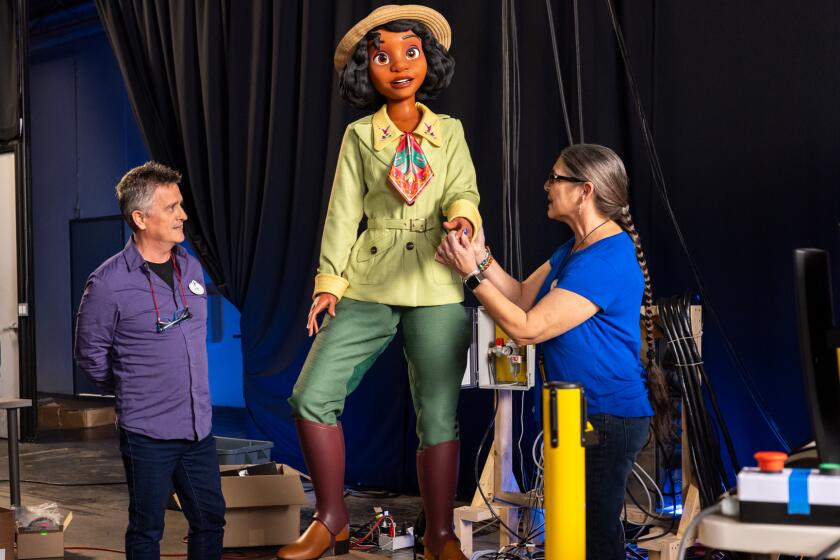
Travel & Experiences
Want to see Disneyland’s most advanced animatronics? Visit Tiana’s Bayou Adventure
With new droids at Star Wars: Galaxy’s Edge and some of the most lifelike characters ever created at Tiana’s Bayou Adventure, Disney is looking to wow guests.
April 4, 2024
Consider a large-scale “Avatar”-inspired land all but a done deal, and the art shared for Disneyland isn’t an exact replica of Florida’s Pandora — The World of Avatar, which resides in that coast’s Animal Kingdom park. Now where to put it? Expect Pandora to be bound for Disney California Adventure. There’s been speculation that it could replace the area currently served by water ride Grizzly River Run or move into a largely vacant slot of Hollywood Land, but neither is ideal. The latter requires a rerouting of the monorail, and Grizzly River Run remains a popular attraction.
Here’s betting it’s positioned in one of the DCA expansion areas near the Pixar Place Hotel, as that would allow the company to give the James Cameron property a plethora of space, especially if Disney must hide a large show building behind an illusion of floating mountains.
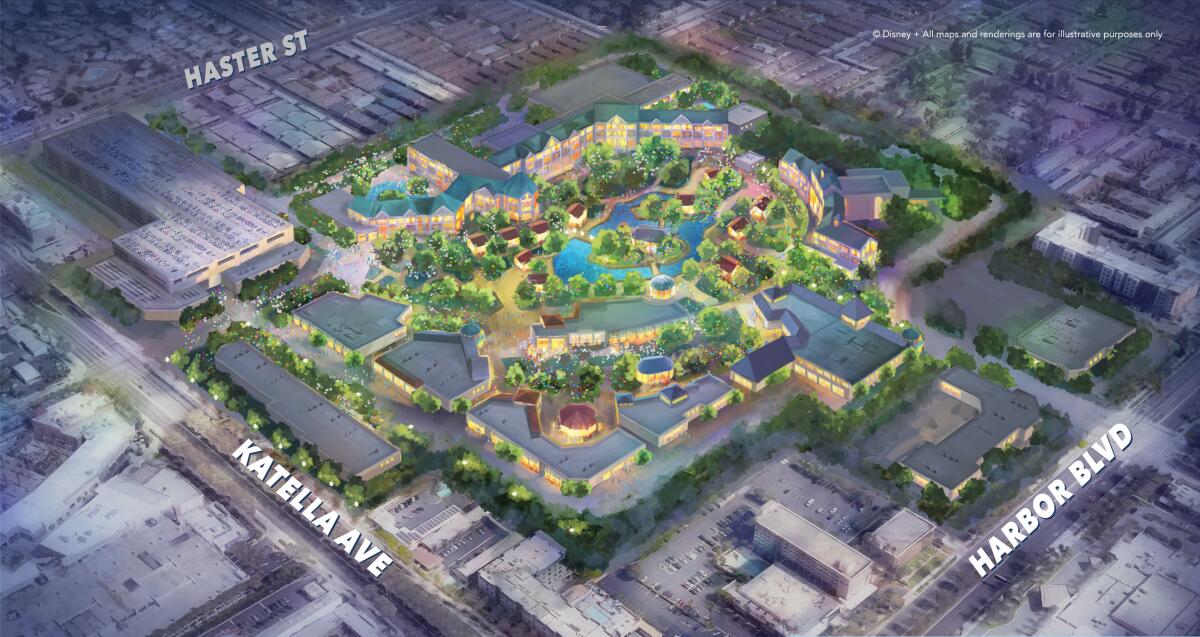
Expect more hotel options
With Disneyland lacking the acreage of Florida’s Walt Disney World, hotel prices in Anaheim are at a premium. Rooms for the recently revamped Pixar Place Hotel — Anaheim’s “budget” option — can routinely top $500 per night. More hotel space is needed, and if Disneyland goes all-in on “Avatar,” expect lodging and more entertainment options to follow close behind. Disney has long touted development of the Toy Story Lot as prime space for hotel, dining and entertainment modeled after Florida’s Disney Springs district.
The DisneylandForward materials mention the land as “the perfect location to cater to locals, conventioneers, hotel and Disneyland Resort guests with restaurants, hotels, live music, shopping, ticketed shows and theme park experiences.” A new proposed parking structure to the north would solve the parking issue, and Disney has done extensive research on this already, as it was part of an earlier, pre-pandemic planned development known as the “Eastern Gateway.”
Walkways to and from the new parking structure would connect the current resort to the new entertainment area. And while fans may want Disney to rapidly fill the available space with theme park attractions, if the resort is planning to increase capacity it’s first going to need a spot for those guests to park. Additionally, Iger at a recent media event said the company likely would hold back some of its theme park funds so the organization could move on the popularity of new films or franchises.
“We actually have a fairly good idea in the near term of what’s being built, but we’re purposefully not going to allocate it all,” Iger said. “Because who knows? In five years we can end up with a giant hit movie — think ‘Frozen’ — that we may want to mine essentially as an attraction, or a hotel or restaurant in our parks. So you want to maintain some flexibility.”

What about ‘Frozen’s’ Arendelle? Or a ‘Coco’-themed experience?
Beyond “Avatar,” which seems a sure thing as it’s been mentioned by Iger on multiple occasions, any future aspects of DisneylandForward become pure speculation. But a couple of franchises may have higher priority than others.
Disney now has a “Frozen” attraction in Walt Disney World, a land in Hong Kong and experiences in the works for Disneyland Paris and Tokyo DisneySea. Walt Disney Imagineering, the company’s secretive arm devoted to theme park experiences, clearly has done the work on bringing “Frozen” to life in physical spaces, and it stands to reason that expansions to the original Disneyland Park, with its fairy-tale feel, would go more of a Fantasyland-inspired route.
What’s more, re-creating Arendelle in the expansion plots located near the Disneyland Hotel would give Disney the opportunity to construct a second castle, as any extensive changes to park centerpiece Sleeping Beauty Castle are prohibited due to structural limitations . The enduring popularity of “Frozen” seems relatively assured at this point, so bringing the franchise to Disneyland is far from a risk.

The unmissable addition to Disneyland’s Star Tours ride? Space whales
Star Tours has become one of Disneyland’s most versatile attractions, and its latest update nods to series such as ‘The Mandalorian,’ ‘Ahsoka’ and ‘Andor.’
April 9, 2024
But if the company opts to create something unique for Southern California rather than importing Hong Kong’s World of Frozen or Shanghai’s Zootopia, one franchise that seems to be routinely brought up by executives is “Coco.” When mentioning blue-sky concepts last year year at an investor event in Florida, D’Amaro teased “Coco” as a key film that has yet to be properly explored in the Disney parks.
Potrock again mentioned “Coco” in an op-ed in the Orange County Register touting the benefits of DisneylandForward, writing that the initiative could pave the way for “the chance to celebrate Dia de Los Muertos in a ‘Coco’-themed experience.” Disney California Adventure, of course, is home to a Dia de Los Muertos celebration that does center a short “Coco” show, and the property seems especially ripe for Southern California and our heavily Latino communities. That makes it an opportunity to give Disneyland an unique land not found in other parks while also tapping into the region’s diverse fan base. Walt’s original park deserves no less as it looks ahead to closing out its first century.
More to Read

Why Disney is doubling down on theme parks with a $60-billion plan
April 24, 2024

Column: Disneyland just promised electric cars at Autopia. Gas will be gone by 2026
April 19, 2024

Disneyland’s $1.9-billion expansion project is latest mega investment in the Anaheim resort
Sign up for The Wild
We’ll help you find the best places to hike, bike and run, as well as the perfect silent spots for meditation and yoga.
You may occasionally receive promotional content from the Los Angeles Times.

Todd Martens joined the Los Angeles Times in 2007 and covers a mix of interactive entertainment (video games) and pop music. Previously, Martens reported on the music business for Billboard Magazine. He has contributed to numerous books, including “The Big Lebowski: An Illustrated, Annotated History of the Greatest Cult Film of All Time.” He continues to torture himself by rooting for the Chicago Cubs and, while he likes dogs, he is more of a cat person.
More From the Los Angeles Times

World & Nation
Venice tests 5-euro entry fee for day-trippers as the city grapples with overtourism
April 25, 2024

This must be Larchmont

What to know about California’s new state park, a scenic green space where two rivers meet
April 23, 2024

This must be Topanga Canyon
![tourism and art AWW Media [US]](https://img-s-msn-com.akamaized.net/tenant/amp/entityid/BB1kdTYO.img)
AWW Media [US]
11 Best Travel Destinations for 2024
Posted: April 24, 2024 | Last updated: April 24, 2024

As the world of travel continues to evolve, 2024 promises to be the best year yet for explorers and adventure-seekers around the globe. With travel restrictions a thing of the past and a renewed enthusiasm for international experiences, travelers are eagerly searching for the next great destination to add to their itineraries. The tourism industry is responding with innovative approaches to meet the demand for immersive, authentic, and sustainable adventures, making this an opportune time to discover the best places to visit.
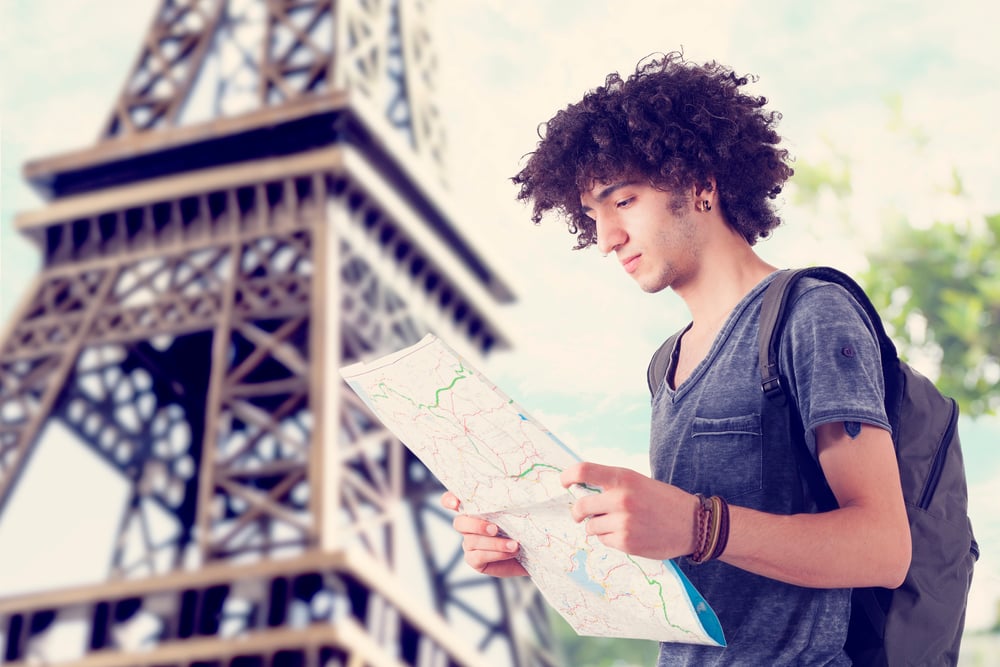
Emerging Trends in Global Travel
The travel landscape for 2024 is defined by enhanced sustainability, cultural intimacy, innovative accommodations, and a richer approach to local cuisines. As travelers seek new experiences, technology, and services, the emergence of diverse travel niches, from art-focused journeys to wilderness adventures, indicates a dynamic shift in global travel trends.
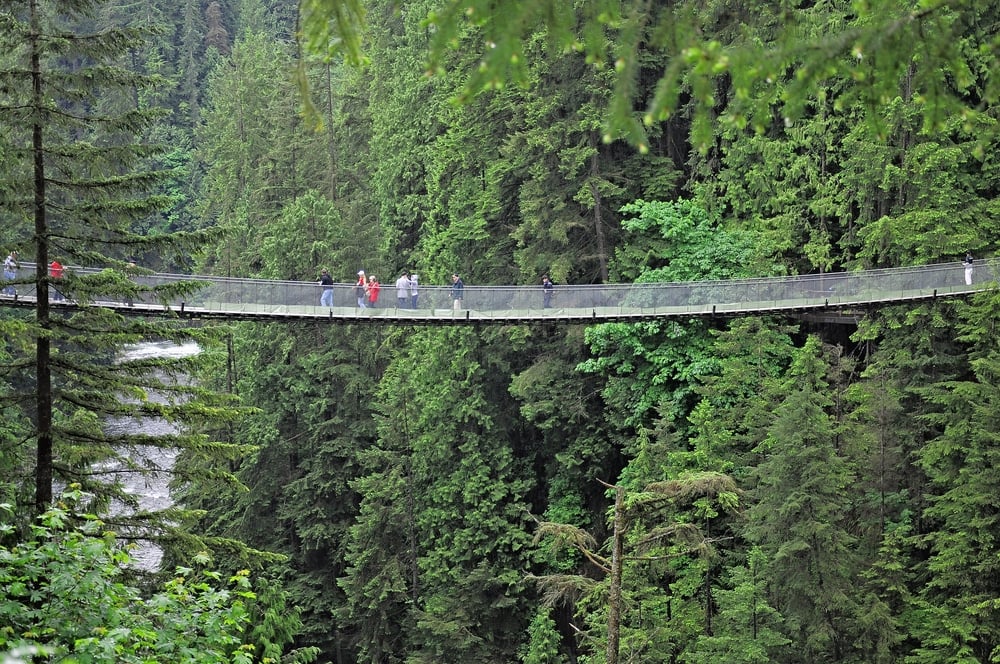
Sustainable and Eco-Tourism
Sustainable travel is increasingly important for travelers who wish to minimize their environmental impact. Destinations such as France are leading the way with eco-friendly practices and accommodations. Eco-tourism is not just a trend; it’s a responsible approach to exploring the world while preserving it for future generations.
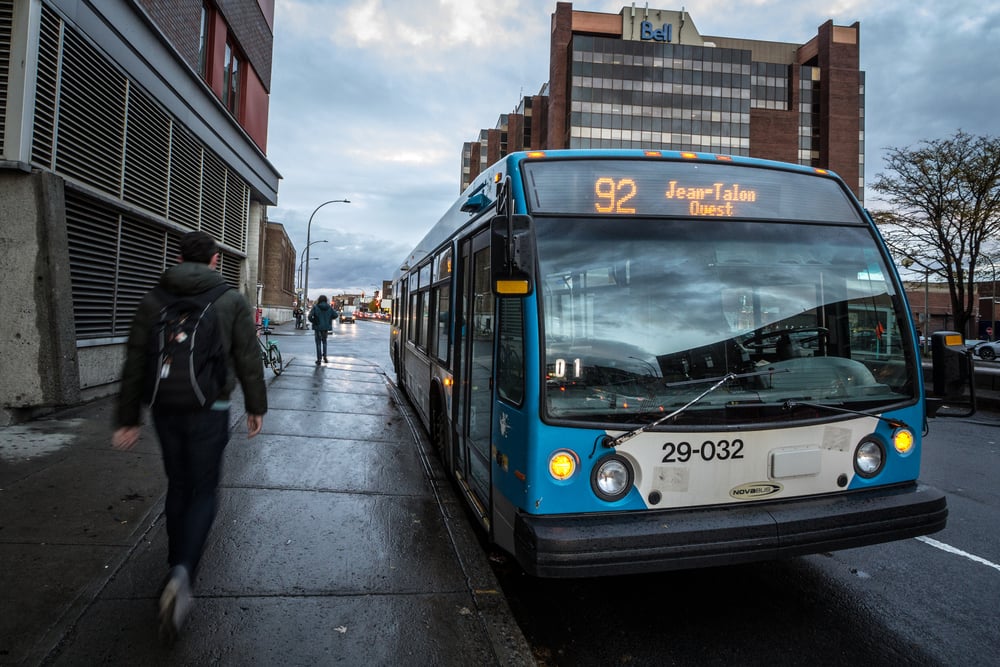
The Rise of Indigenous Tourism
Indigenous tourism offers authentic cultural experiences and is gaining popularity among travelers who seek to understand and respect the cultural heritage of the places they visit. Notably, this form of tourism supports indigenous communities economically and socially.
Canada is one of the leaders in Indigenous Tourism an d British Columbia has some great tourism ideas.
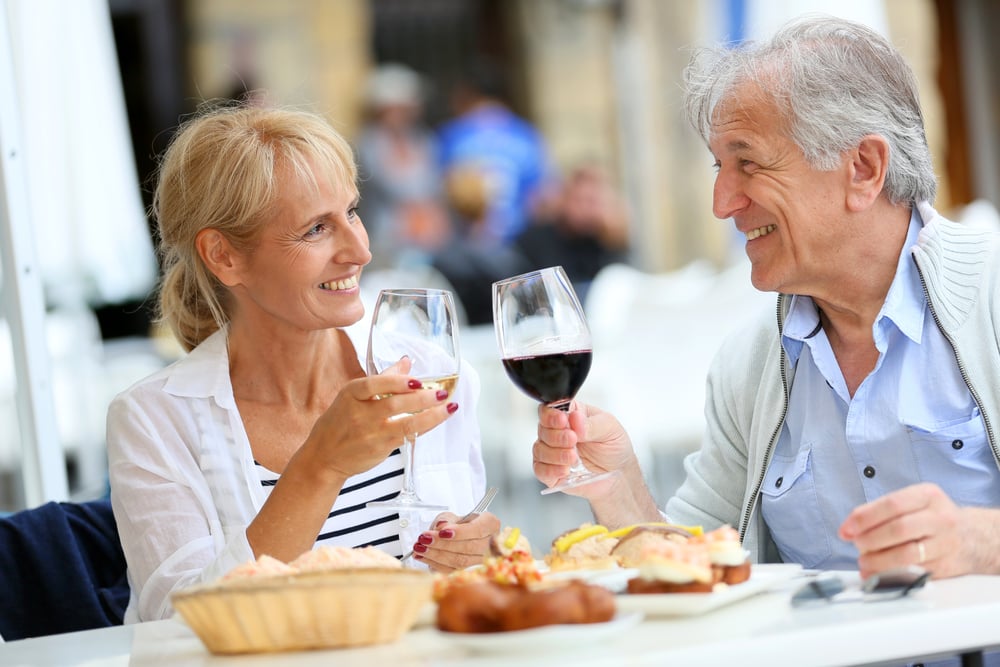
Culinary Explorations and Experiences
The culinary scene has become inseparable from travel. Gastronomic experiences, from street food in Lima to Michelin star dining in Rome, are vital in many people selecting destinations. These edible explorations serve as cultural gateways for travelers.
Foodie Cities:
- Rome: Renowned for its Michelin-star offerings
- Lima: Celebrated for innovative culinary delights
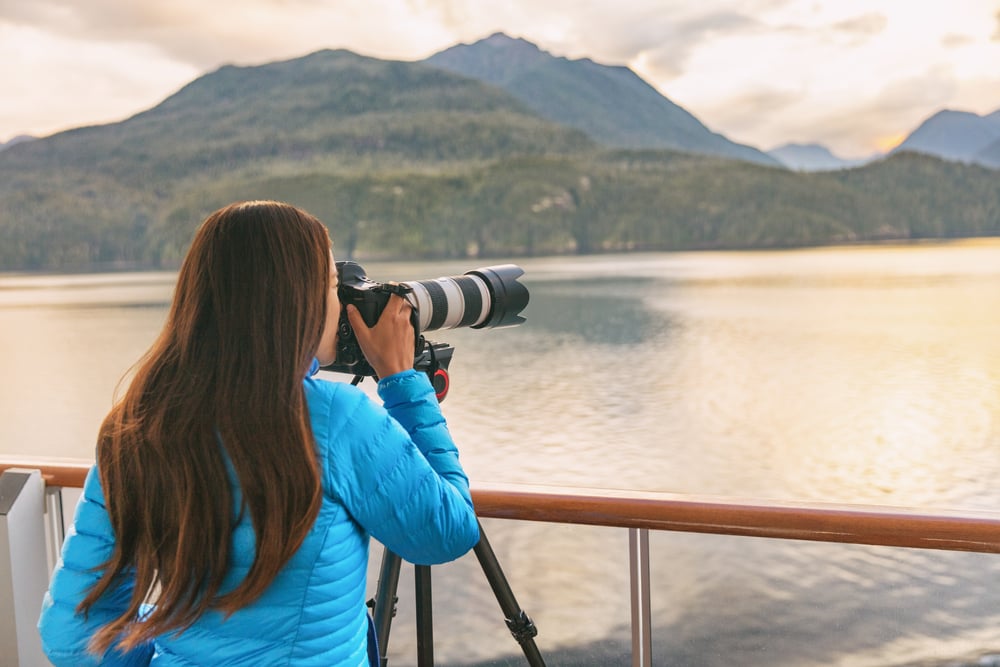
Adventure and Wellness Travel
Travelers are increasingly drawn to combining adventure travel with wellness experiences. Journeys geared towards the body and spirit are gaining traction, with an emphasis on UNESCO World Heritage sites, and opportunities like yoga in pristine national parks.
- Rainforests and national parks : Preferred destinations for dual adventure and wellness experiences
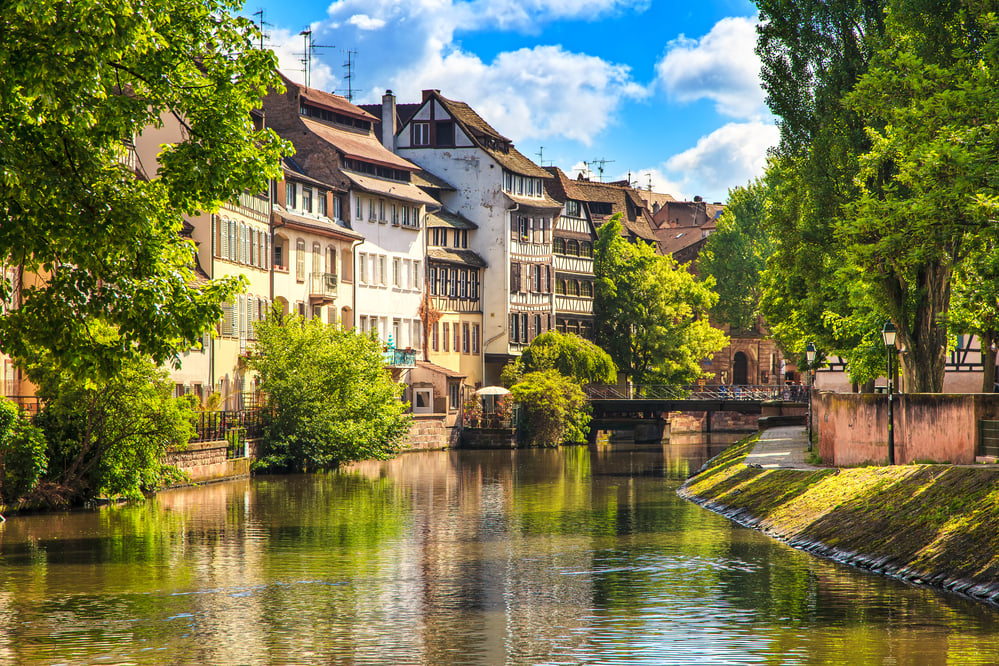
Art and Culture Travel
Cultural travelers are drawn to cities buzzing with artistic movements. Whether it’s the Art Nouveau allure of European cities or the UNESCO-designated sites around the world, art and culture enthusiasts are finding more ways to engage with history and creativity.
- Art Nouveau landmarks and UNESCO World Heritage sites : Attracting art and culture aficionados
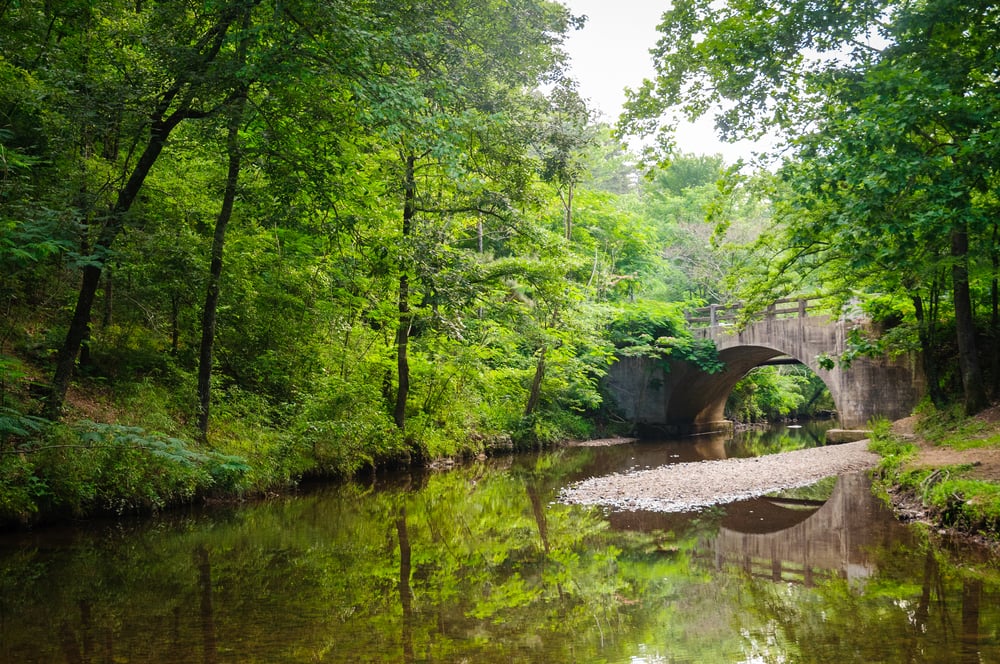
Wildlife and Natural Landscapes
For those captivated by nature, 2024 offers an abundance of wildlife encounters and sprawling natural landscapes. Eco-conscious travelers relish experiences like observing wildlife in their natural habitats or exploring the biodiversity of rainforests.
- National parks and rainforests : Key locations for wildlife enthusiasts
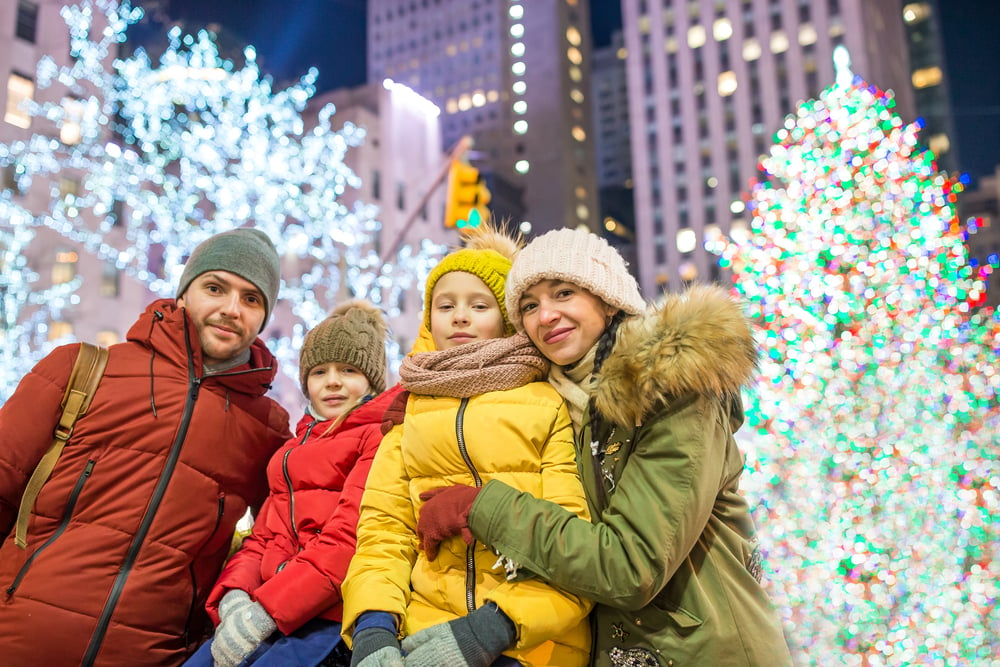
Urban Escapes and City Breaks
The allure of cities never fades, with metropolises like New York offering an ever-evolving landscape for travelers. The fast-paced lifestyle and dense cultural tapestry of urban environments provide an enduring appeal for short yet enriching breaks.
- New York : A perennial favorite for dynamic city experiences
- Boutique hotels and cultural landmarks: Enhancing urban travel experiences

Top Destinations for 2024
The upcoming year offers an array of destinations for every type of traveler, focusing on uncharted European locales, bustling Asian metropolises, North America’s varied terrain, South American culture, Africa’s natural wonders, Australia’s distinct offerings, India’s immersive experiences, and Scandinavia’s pristine beauty.
Europe’s Hidden Gems
While Paris and Rome remain timeless, 2024 is the year to explore Bodrum , Turkey. Once a quiet fishing village, Bodrum has transformed into a luxurious escape, boasting high-end resorts such as the Hilton Bodrum Turkbuku Resort & Spa . In Eastern Europe, the serene landscapes and rich history of cities like Istanbul captivate visitors looking for both modernity and tradition.

Asia’s Must-Visit Cities
Asia’s megacities continue to thrive, with travelers drawn to the high-speed energy of places like Tokyo . For a change of pace, the Eastern & Oriental Express offers a luxurious rail journey connecting the wonders of Singapore, Malaysia, and Thailand. Hong Kong and Seoul also top the list, offering cutting-edge urban experiences alongside rich cultural heritage.
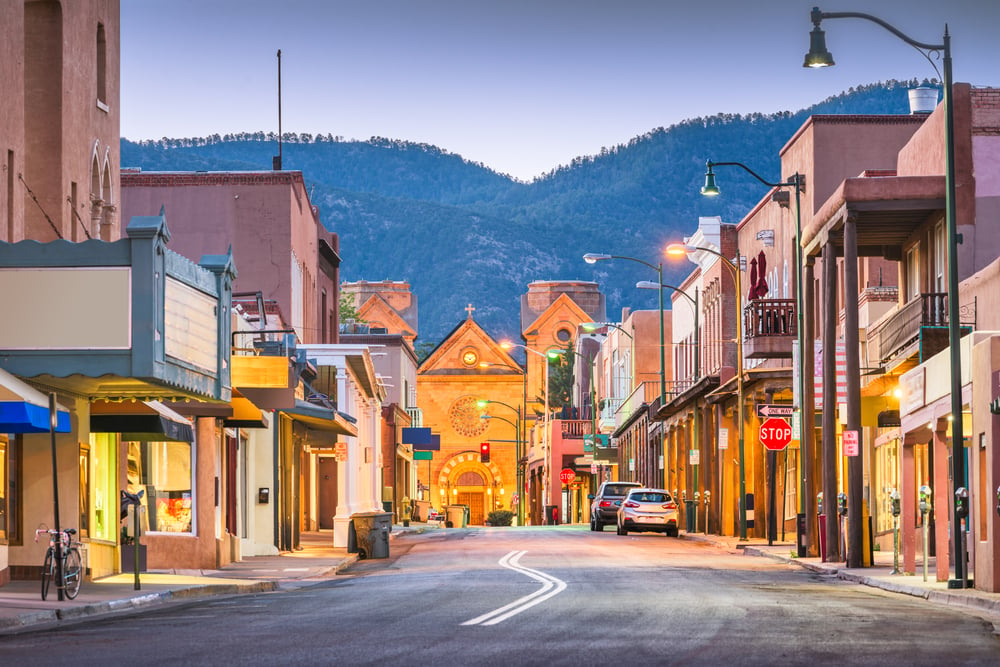
North America’s Diverse Landscapes
North America’s diversity shines in destinations like New York , where cityscapes and culture converge. Santa Fe , New Mexico, is celebrated for its Pueblo-style architecture and vibrant art scene. In Canada, the rugged beauty of places like Banff National Park provides an unrivaled wilderness experience.
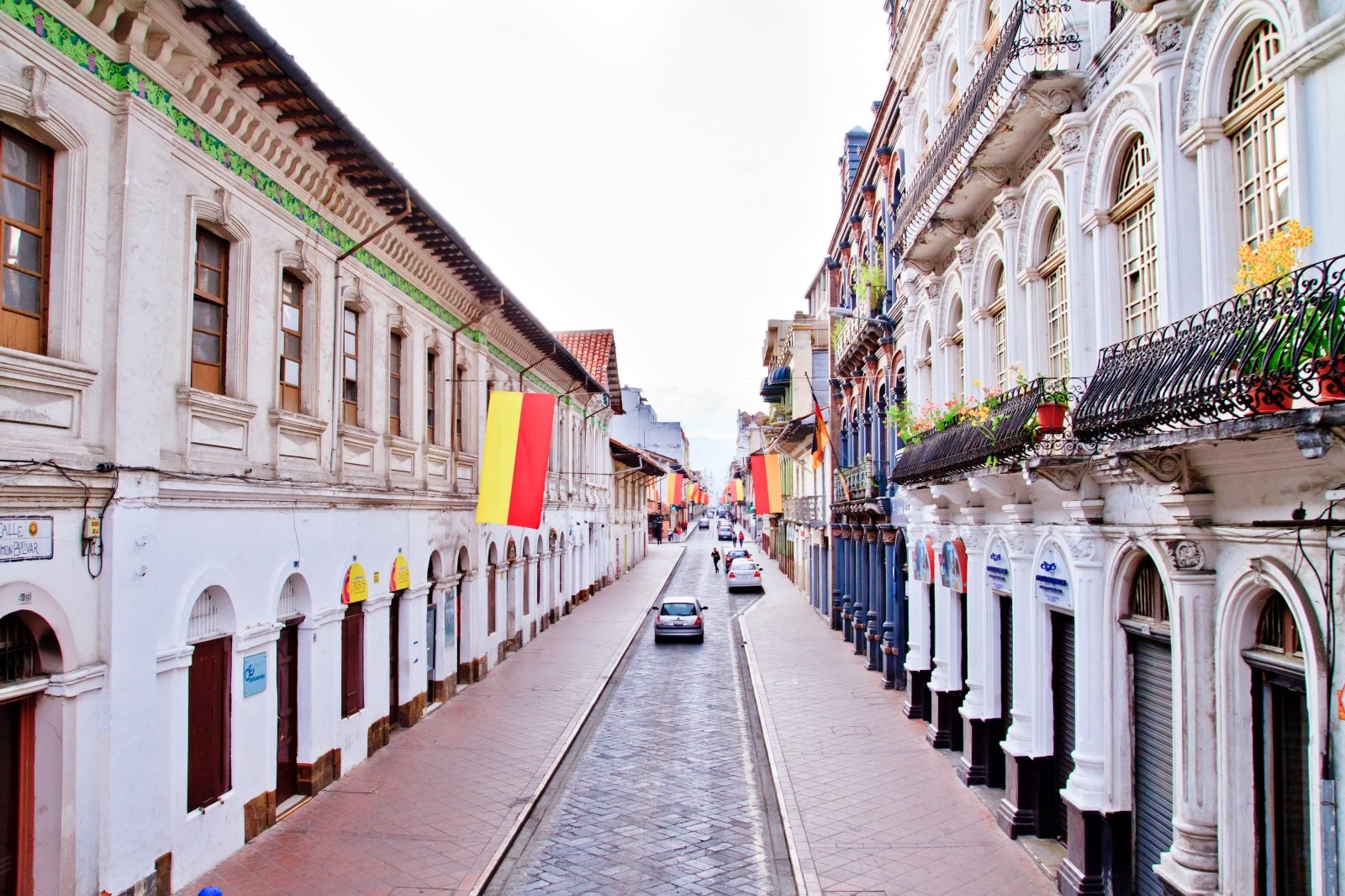
Exploring South America’s Richness
Brazil’s vibrant cities and lush rainforests beckon adventurers and beach-goers alike. Over in Ecuador , Quito stands out as a city teeming with colonial history, nestled among volcanic peaks. The region promises a blend of natural splendor and enriching cultural encounters.
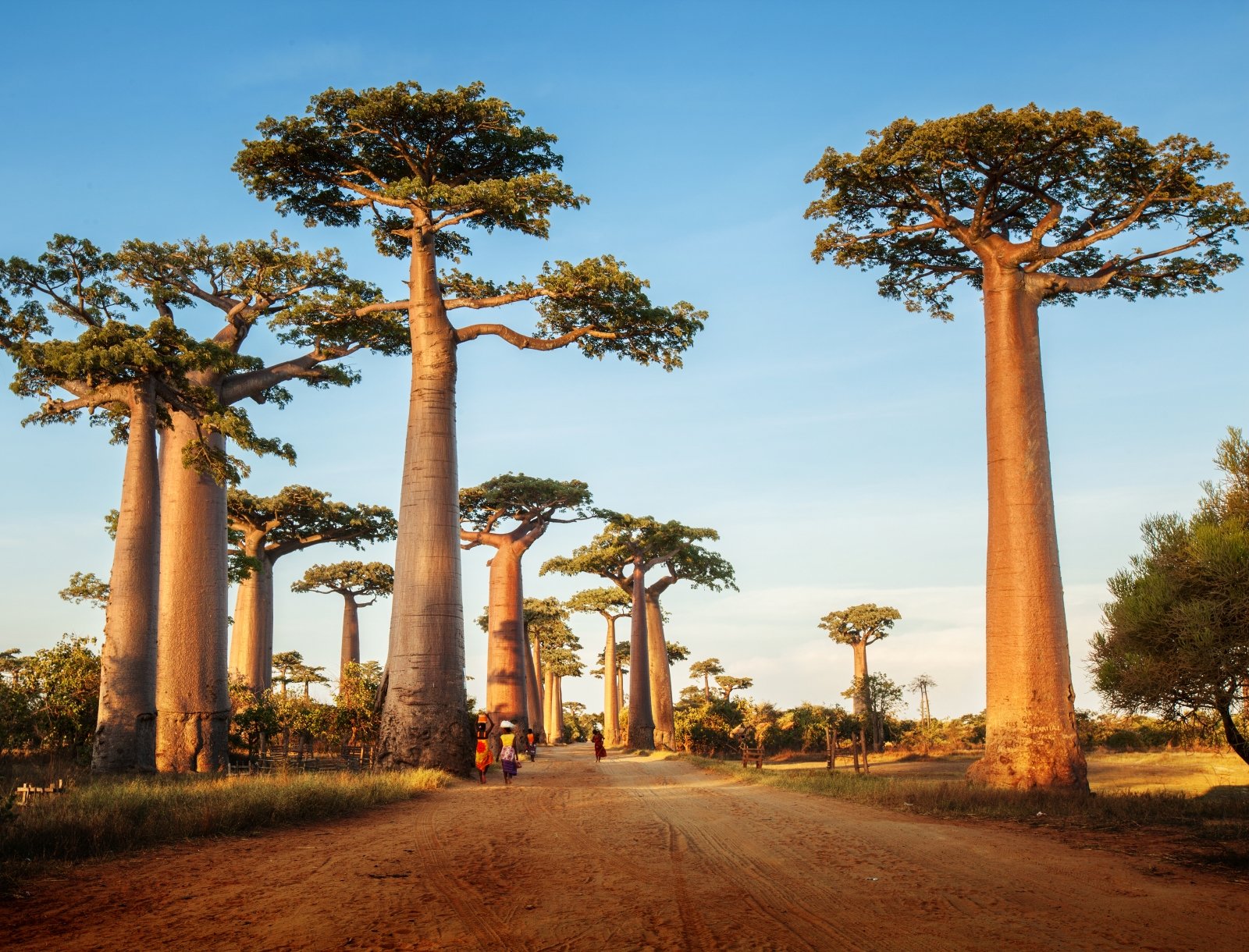
The Best of Africa
Madagascar offers a unique travel experience with its endemic wildlife and breathtaking landscapes, including the Avenue of the Baobabs.

Unique Experiences in Australia and Oceania
Australia presents a tapestry of experiences, from the Great Barrier Reef to the cultural hubs of Sydney and Melbourne. Journey to French Polynesia to discover idyllic islands like Bora Bora, combining luxury and seclusion with their overwater bungalows and pristine lagoons.
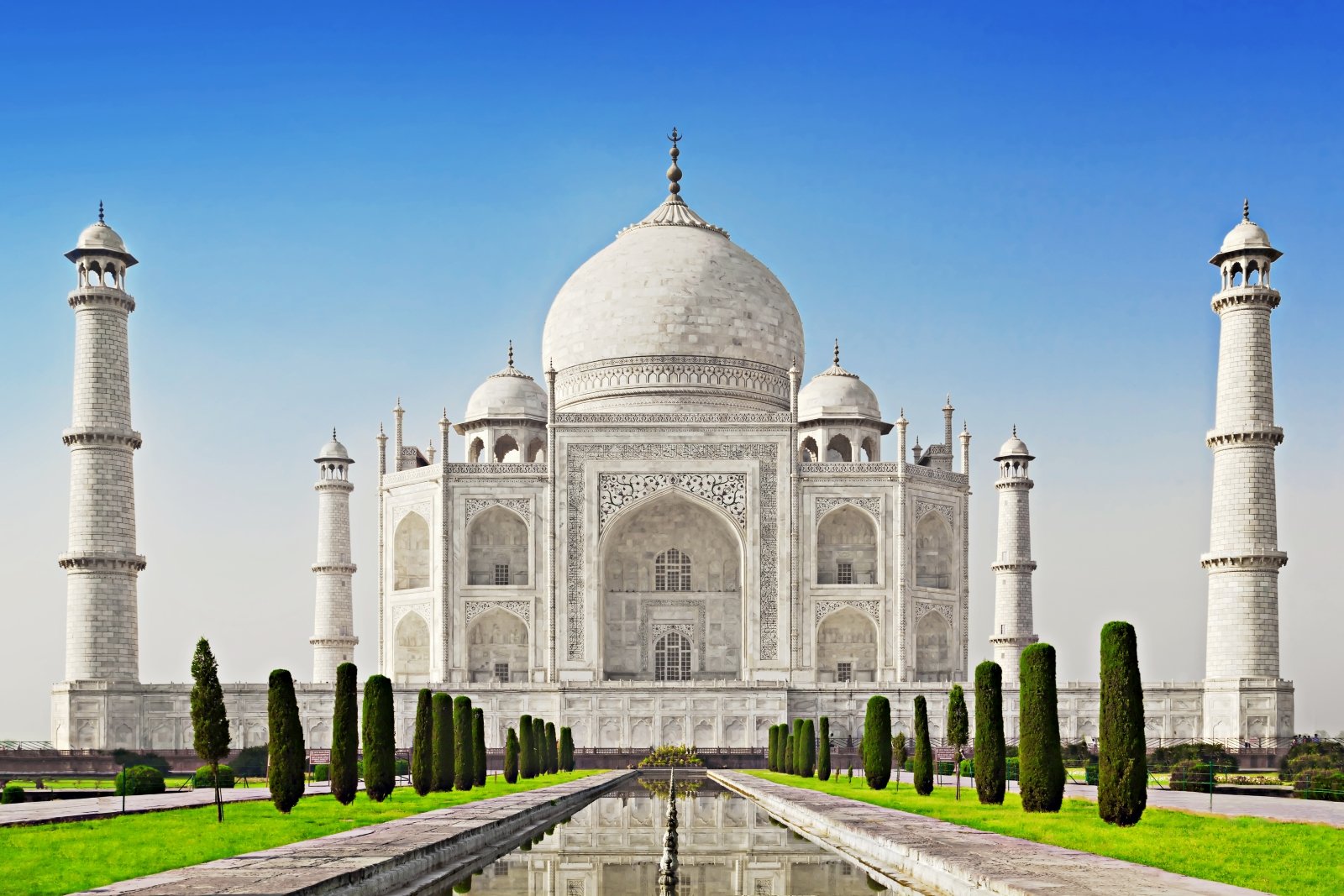
Discovering the Culture and Nature of India
India is a land of contrasts, with Agra ‘s Mughal grandeur at one end and the tranquil backwaters of Kerala at the other. Travelers can immerse themselves in the vibrant colors, profound spirituality, and diverse cultures that thrive within the subcontinent’s borders.
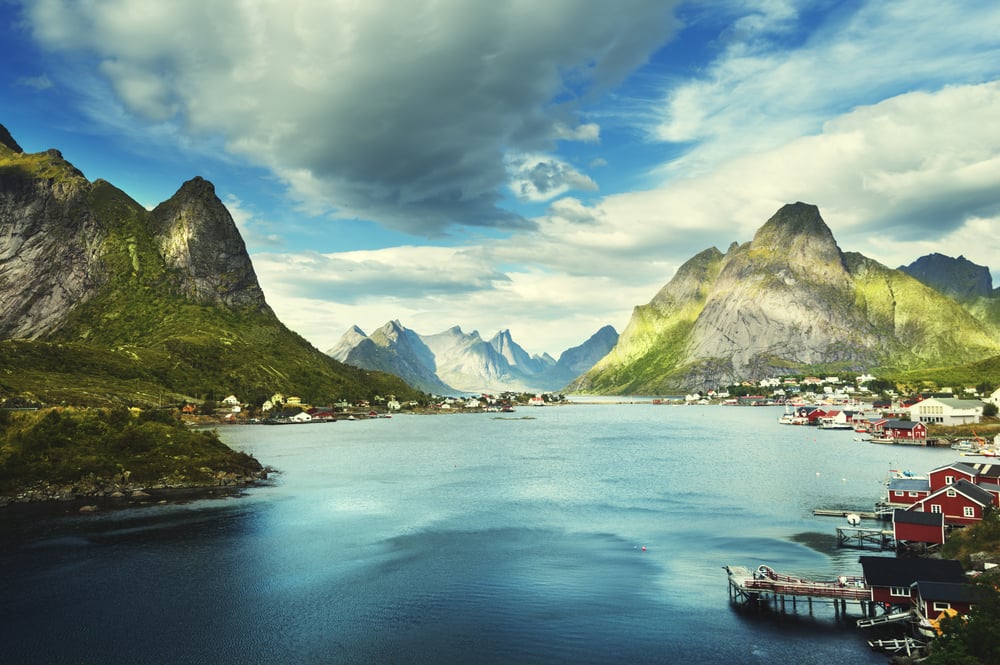
Unforgettable Journeys in Scandinavia and the Nordics
Traveling through Scandinavia, one cannot miss the fjords of Norway or the otherworldly landscapes of Iceland . These regions offer some of the world’s most magnificent natural displays, including the Northern Lights and the Midnight Sun, contrasting with the cutting-edge Nordic cities known for design and sustainability.

Seasonal Travel Guide for 2024
Selecting the right destination based on the season can greatly enhance a traveler’s experience. This guide highlights optimal destinations and activities for each season in 2024, considering factors like weather, seasonal experiences, and the best times to visit.
![Winter Wonders: December to February <p><strong>[Iceland – December]:</strong> One can witness <strong>Iceland’s enchanting winter landscapes</strong> and have a chance to observe the Northern Lights. Despite the cold, travelers are rewarded with fewer crowds and the potential for a magical New Year celebration under the aurora borealis.</p><p><strong>[Mediterranean – January]:</strong> While typically less crowded during winter, some Mediterranean destinations offer mild climates ideal for exploring historic sites without the heat of summer. However, beach activities may be limited during this time.</p><p><strong>[Paris – February]:</strong> Paris in February can be cold, but it’s an excellent time to visit indoor attractions like museums and galleries. The after-holiday lull results in shorter lines and the romance of the city is amplified around Valentine’s Day.</p>](https://img-s-msn-com.akamaized.net/tenant/amp/entityid/AA1nAG04.img)
Winter Wonders: December to February
[Iceland – December]: One can witness Iceland’s enchanting winter landscapes and have a chance to observe the Northern Lights. Despite the cold, travelers are rewarded with fewer crowds and the potential for a magical New Year celebration under the aurora borealis.
[Mediterranean – January]: While typically less crowded during winter, some Mediterranean destinations offer mild climates ideal for exploring historic sites without the heat of summer. However, beach activities may be limited during this time.
[Paris – February]: Paris in February can be cold, but it’s an excellent time to visit indoor attractions like museums and galleries. The after-holiday lull results in shorter lines and the romance of the city is amplified around Valentine’s Day.
![Spring Escapes: March to May <p><strong>[Cherry Blossoms – March/April]: Japan’s</strong> cherry blossom season is a splendid time to stroll through blooming gardens and partake in hanami, the traditional viewing picnics. These months offer a mesmerizing experience as the pink and white colors adorn cities.</p><p><strong>[Paris – May]:</strong> <strong>Paris</strong> in spring blossoms with not just flowers in Luxembourg Gardens but also with visitors. The moderate climate and blooming gardens make it the best time to visit before the peak tourist season begins.</p>](https://img-s-msn-com.akamaized.net/tenant/amp/entityid/AA1nAKJj.img)
Spring Escapes: March to May
[Cherry Blossoms – March/April]: Japan’s cherry blossom season is a splendid time to stroll through blooming gardens and partake in hanami, the traditional viewing picnics. These months offer a mesmerizing experience as the pink and white colors adorn cities.
[Paris – May]: Paris in spring blossoms with not just flowers in Luxembourg Gardens but also with visitors. The moderate climate and blooming gardens make it the best time to visit before the peak tourist season begins.
![Summer Getaways: June to August <p><strong>[Beaches – June to August]:</strong> Summer is ideal for beach vacations, and the Mediterranean shines with hotspots like the A<strong>malfi Coast.</strong> Travelers can enjoy the sun-soaked shores, azure waters, and lively coastal towns during these peak months.</p><p><strong>[Europe – August]:</strong> Europe in August thrives with tourists. Destinations like<strong> Greece, Spain, and Italy</strong> embrace the warm weather with open-air festivals, markets, and abundant outdoor dining options.</p>](https://img-s-msn-com.akamaized.net/tenant/amp/entityid/AA1nARny.img)
Summer Getaways: June to August
[Beaches – June to August]: Summer is ideal for beach vacations, and the Mediterranean shines with hotspots like the A malfi Coast. Travelers can enjoy the sun-soaked shores, azure waters, and lively coastal towns during these peak months.
[Europe – August]: Europe in August thrives with tourists. Destinations like Greece, Spain, and Italy embrace the warm weather with open-air festivals, markets, and abundant outdoor dining options.
![Autumn Adventures: September to November <p><strong>[Foliage – September/October]:</strong> As autumn unfurls, regions like<strong> New England</strong> in the United States and the <strong>Alps in Europe</strong> display spectacular foliage. The crisp weather is perfect for hiking and enjoying the kaleidoscope of fall colors.</p><p><strong>[Autumn Festivals – October/November]:</strong> Europe continues to dazzle with autumn festivals celebrating the harvest. From <strong>wine festivities in France to Germany’s Oktoberfest</strong>, the cooler temperatures and dimming crowds can make for a festive and comfortable holiday.</p><p>I hope this gets you excited for travel this year and if you can find something I should have on my radar, let me know.</p>](https://img-s-msn-com.akamaized.net/tenant/amp/entityid/AA1nATw6.img)
Autumn Adventures: September to November
[Foliage – September/October]: As autumn unfurls, regions like New England in the United States and the Alps in Europe display spectacular foliage. The crisp weather is perfect for hiking and enjoying the kaleidoscope of fall colors.
[Autumn Festivals – October/November]: Europe continues to dazzle with autumn festivals celebrating the harvest. From wine festivities in France to Germany’s Oktoberfest , the cooler temperatures and dimming crowds can make for a festive and comfortable holiday.
I hope this gets you excited for travel this year and if you can find something I should have on my radar, let me know.
More for You
Here's No. 1 thing mentally strong couples 'never' do, says relationship therapist of 20 years
Sports Cars As Cool as the Porsche 911 But Way More Affordable
19 Things That Will Happen When You Stop Drinking Alcohol
Kamala Harris was annoyed after NY Times publisher confronted her over Biden not doing interviews: Report
Steelers make notable decision on QB Justin Fields
The most expensive state to live in isn't California or New York, based on data. Here are the top 10.
'10-foot-tall people' discovered by archaeologists in Nevada cave

Netflix hit watched more than 21 million times in its first three days
The Coolest Car From the Year You Were Born (1945-1995)
People Who Don’t Show Empathy Usually Have These 18 Traits
Peyton Manning takes aim at Jets over Zach Wilson's failed tenure: 'It drives me crazy'
How many of these '80s one-hit wonders do you remember?
3 lies women have been told about their bodies, according to a female doctor
What is the correct answer? 6² ÷ 2(3) + 4 = ? Mathematicians explained it correctly
Government watchdog alleges Trump campaign broke the law trying to hide legal payments
6 Questions You Should Never Ask at a Car Dealership
Frontline Ukrainians Fear New Aid From U.S. Will Be a Disaster
25 famous rock song lyrics everyone gets wrong
The Factory Turbocharged Car With The Most Horsepower In 2024
Scientists finally confirm what lies inside the Moon
- Latin America
- Expat Living
- Art and Culture
- Science and Tech
- Classifieds
- Advertise with Us

COSTA RICA'S LEADING ENGLISH LANGUAGE NEWSPAPER
How did the Costa Rica President Pay For His House?
Costa rica’s declining press freedom highlighted in us report, costa rica, uae sign economic partnership agreement, why costa rica farmers are going out of business, netflix spends $1.2m on security for costa rica filming, the rise of brazilian funk: anitta, beyoncé, and beyond.
From Anitta to Beyoncé, through exhibitions and artistic residencies, funk has left the favelas of Rio to become a global phenomenon. However, prejudices still persist in Brazil.
With influences from hip hop, electronic music, and a good dose of Afro-Brazilian percussion, this music emerged in the late nineties in Rio, from where it expanded to Sao Paulo, Recife, Belo Horizonte, and other large cities in the country. “Funk feeds the self-esteem of the favela,” said writer Taisa Machado, creator of the Afrofunk Rio promotion platform.
“Those of us who work with funk have always known about the strength, musical and cultural quality of the movement, and we were already waiting for this moment,” she notes about its international momentum.
She celebrated, as many did, that American superstar Beyoncé included in her most recent album, “Cowboy Carter”, a song (“Spaghettii”) with a sample from Brazilian artist O Mandrake, a legend of the genre.
Brazilian artist Anitta, the biggest architect of this global projection, proclaims that pride in her new album “Funk Generation”, which hits the market this Friday. Meanwhile, her colleague Ludmilla performed at the recent Coachella festival in California.
Live off my art
In Lapa, a central working-class neighborhood of Rio, a dozen young people from the suburbs and favelas rehearse their final show for #estudeofunk, an “artistic residency” taught at the Fundição Progresso cultural center.
It’s the turn of four girls who, dressed in sports tops and shorts, do “quadradinhos” with their hips under the watchful eye of Celly, the dance director. The idea of the project is to “professionalize” their knowledge and turn their passion into a profitable career, summarizes its creator, Vanessa Damasco.
The success of “funkeiros” artists inspires thousands of people who see them, like soccer players, as a model for economic advancement and life improvement.
“To be able to live off my music, my art, that’s what I want,” confirms Gustavo de França Duarte (MC Gut Original) after the rehearsal. At 35 years old with four children, he has been singing funk for years but works as a night watchman.
Museum piece
The Rio Art Museum also echoes the phenomenon. In “Funk, a Cry of Boldness and Freedom”, hundreds of paintings, photos, videos, and installations mark emblematic moments of dances in poor neighborhoods and nightclubs.
The exhibition also addresses the demand for sexual freedom in Rio’s funk and its dimension of self-management thanks to the internet. It highlights moments such as when Olympic medalist Rebeca Andrade set her performance in Tokyo-2021 to the song “Baile de favela”.
The good public reception led the museum to extend the duration of the exhibition. One of the exhibitors is French photographer Vincent Rosenblatt, based in Brazil, whose powerful portraits taken over 15 years at funk parties were also exhibited in Paris this year. He recalls that funk “had to go through a great struggle to be recognized as Rio’s cultural heritage” in 2009.
On the same day that the Rio legislative assembly granted it that recognition, it revoked a law that restricted funk parties, the massive street celebrations in favelas and other urban spaces.
Like a phoenix
Funk speaks about “the daily life of the favela, the new habits of the youth, the way of speaking, the expressions, and the slang,” says anthropologist and documentary filmmaker Emílio Domingos, responsible for the script of the Netflix series “Anitta: From Honorio to the World”.
“The lyrics cite the favela as a space of pride and leisure,” he adds. But, by sharing territory with drug trafficking, they also talk about violence, which fueled the stigma that still hangs over the movement.
Because paradoxically, while its popularity explodes outside, there are fewer and fewer funk parties in Brazil. “Funk moves a lot of money, employs many people, raises relevant debates, and has the power to promote new lines of behavior, and yet there is a real police and state persecution,” Machado denounces.
“There are many prejudices, racism, machismo, and elitism when dealing with the movement,” she laments. Rosenblatt agrees but celebrates that funk is “like a phoenix: the more they repress it, the more it is reborn somewhere else.”
Weekly Recap
Costa rica weekly recap news recap april 21, 2024: plastics, vaping and tourism.

Latest Articles
Firefighters battle blaze in caño negro national wildlife refuge, the difficulty of enforcing laws on feeding wild animals, costa rica faces water supply challenges amid severe drought, costa rican hotels shine in travel+leisure’s best 100 list.

- LIVE DISCOURSE
- BLOG / OPINION
- SUBMIT PRESS RELEASE
- Advertisement
- Knowledge Partnership
- Media Partnership
Moscow City Tourism Committee organizes conference for Indian MICE market stakeholders
Recognising market demand, the moscow city tourism committee organized a conference for representatives of the indian mice industry, to introduce them to the tourism strengths of the russian capital..

Recognising market demand, the Moscow City Tourism Committee organized a conference for representatives of the Indian MICE industry, to introduce them to the tourism strengths of the Russian capital. MICE stands for Meetings, Incentives, Conferences and Exhibitions, and is a type of tourism in which large groups, usually plan things well in advance.
The event took place on April 19 in Delhi and brought together over 100 participants from MICE agencies of both countries, corporate customers, representatives of the travel industry in Moscow, Aeroflot and the Indian branches of Sberbank. Business tourism is one of the most promising directions for Moscow.
In 2023, the capital was visited by 3.7 million business tourists - 7 per cent more than in 2022. And India remains one of the leaders among visitors from non-CIS countries in terms of the number of business travellers. "The Russian capital as a centre of business tourism and corporate events is already an established and a strong brand in the international arena," commented Anastasia Popova, Deputy General Director for International and Industry Cooperation of Project Office for the Development of Tourism and Hospitality in Moscow.
"Now our task is to demonstrate to our Indian partners all the possibilities of organizing high-value MICE events in Moscow in combination with already proven tourist programs," said Popova. At the Shaping MICE Future Conference, industry experts from Russia and India pronounced statements and speeches on the future of MICE events in these two countries, a presentation of the MICE potential of Moscow was showcased, and an analytical report on the state of the outbound MICE market in India was presented to the visitors.
During the panel discussion, participants assessed the current status and interaction peculiarities with the MICE market in India and developed recommendations for the MICE industry in Moscow during the general brainstorming session. Representatives of the Indian MICE industry participated in B2B negotiations to find new cross-partners in the Moscow business environment and among representatives of the hospitality industry.
Representatives of the MICE industry took part in the event from Moscow. Among them were DMC (Grand Rus, Academservice, Headed Goose, Satguru Travel, Isba Rus, Hug the Bear, Mellenium Group) as well as representatives of other partners interested in the development of MICE cooperation between Russia and India: Global transfers provider i'way and hotels Edge Seligerskaya and Edge Vinogradovo Moscow by Rotana.
"In 2024, we have witnessed a significant surge (more than quadruple) in the demand for transfers by Russians visiting India, both for business and leisure purposes. Muscovites are leading the trend, with 80 per cent of transfer bookings originating from the capital since the beginning of the year. Additionally, we observe a growing interest from Indian tourism agencies in exploring Russia, resulting in a substantial increase in our collaboration," commented Dmitriy Saraykin, co-founder of Global Transfer Provider i'way. The Shaping MICE Future conference allowed the Moscow City Tourism Committee to form a pool of MICE industry representatives in Moscow to prioritize incoming requests for events and clarify India's requirements for business and corporate events to build mutually effective work. Indian colleagues received up-to-date information about Moscow as a safe and attractive MICE destination and were able to find potential partners among representatives of the MICE industry of the Russian capital and were able to present the MICE market in India.
"The event served as a remarkable platform for fostering meaningful dialogue and collaboration within the tourism industry. The event provided us with invaluable opportunities to engage with key stakeholders from the tourism department, as well as tour operators and service providers. The insights gained during the event underscored the Moscow City Tourism Committee's keen interest in the Indian outbound market, and we are optimistic about the promising prospects for Moscow as a destination, particularly in the post-pandemic landscape. We firmly believe that with concerted efforts and strategic initiatives, Moscow has the potential to emerge as a top-choice destination for Indian tourists," said Mudit Mathur, director of Tours Delite India, representing Academ Service - Russia in India. The conference also assessed the solutions to foreign demand for non-standard venues and elements in MICE programs, such as museums, parks, theaters and others. Holding MICE events at offbeat locations, such as the State Historical Museum, the Moscow Planetarium and Khudozhestvenny Cinema, is becoming popular.
This helps to attract conference organizers and creates a unique experience for the participants. Working in this format, many visitors who come to Moscow on a business trip want to return with their families and spend time as regular tourists. (ANI)
Floods swamp swathes of Russia and Kazakhstan but worse still to come
Biden and japan's kishida forge new partnership, eyeing china and russia, russia intensifies crackdown on dissent by placing additional kremlin critics on wanted list, russia launches 'counter-terrorist operation' in southern region, ria reports, water levels rise in russian rivers in flooding zone.

Battling climate change, Japan looks to seagrass for carbon capture

Zomato Celebrates Plastic-Free Innovations with Packathon Winners

Reuters US Domestic News Summary

Global immunization efforts saved 154 million lives over past 50 years: The ...
Latest news, us-led effort to deliver aid to gaza by sea gains momentum amidst lingering challenges, morocco tenders for 400 mw wind farm, indigenous people protest brazil not protecting ancestral lands, haiti transitional government takes power as gangs hold capital 'hostage'.

OPINION / BLOG / INTERVIEW
Sustainable tech: innovations in green computing and energy efficiency, vertical cities: architectural innovations and the future of urban living, the intersection of artificial intelligence, automation, and human contribution, the digital divide in urban areas: addressing connectivity and accessibility, connect us on.
- ADVERTISEMENT
- KNOWLEDGE PARTNERSHIP
- MEDIA PARTNERSHIP
- Agro-Forestry
- Art & Culture
- Economy & Business
- Energy & Extractives
- Law & Governance
- Science & Environment
- Social & Gender
- Urban Development
- East and South East Asia
- Europe and Central Asia
- Central Africa
- East Africa
- Southern Africa
- West Africa
- Middle East and North Africa
- North America
- Latin America and Caribbean
OTHER LINKS
- Write for us
- Submit Press Release
- Opinion / Blog / Analysis
- Business News
- Entertainment News
- Technology News
- Law-order News
- Lifestyle News
- National News
- International News
OTHER PRODUCTS
Email: [email protected] Phone: +91-720-6444012, +91-7027739813, 14, 15
© Copyright 2024

IMAGES
VIDEO
COMMENTS
This article argues the case for art tourism as a new field of tourist studies. At present, art tourism is currently obscured under cultural tourism's voluminous bounds - which are as inappropriate as they are unwieldy and overloaded. More specifically, it cannot adequately contain art tourism's distinctive origins, forms of experience ...
This article argues the case for art tourism as a new field of tourist studies. At present, art tourism is currently obscured under cultural tourism's voluminous bounds - which are as inappropriate as they are unwieldy and overloaded. More specifically, it cannot adequately contain art tourism's distinctive origins, forms of experience ...
Interview questions focused on perceptions of art tourism, on the role of artists, and on the relation between art and culture in this fifty years old country. Findings exhibit a sense of optimism especially in relation to the newly opened Louvre, which has boosted art tourism in the UAE. However, the real art market is neglected and under ...
Various artistic initiatives are paving the way for sustainable tourism by promoting cultural exchange and supporting local communities. Here are a few notable examples: 1. Street Art in Urban Spaces. Street art has become a powerful form of artistic expression that can transform urban spaces and engage both locals and tourists alike.
Art tourism, known also as arts tourism or arts-related tourism, is defined as "any tourism that includes a visit to the arts (regardless of initial interest, etc.)," as "consumption of contemporary culture" (Hughes 2003: 2, 53). Furthermore, it is "any activity that involves travel to see art and would include those people who travel ...
Moreover, to analyze papers specifically consisting of the term "art tourism" a theory‐context‐characteristics‐methods structure was used - the authors call these papers art-tourism-specific papers.,While the number of "art and tourism" papers has been increasing in the past 40 years, little is known about "art tourism" as ...
Art, tourism. Art, as a vast subdivision of culture, is composed of many creative endeavors and disciplines. It encompasses visual/plastic arts (traditional fine, modern fine, modern visual, applied, decorative, literature, and music) and performing arts. To the world of tourism, it brings "style, culture, beauty, and a sense of continuity of ...
This book opens up a new field of discussion at the crossroads between contemporary art and critical tourism. As common ground for theoretical inquiry and artistic research, the notion of critical tourism asks us to question again our understanding of authenticity, the tourist gaze, the museification of landscape, the visual construction of place, post-romanticism, contemporary exoticism, site ...
The art performance tourism is favored by tourists nowadays as it reflects cultural connotation of tourism products, releases cultural charm of tourism destinations, and meets tourists' pursuit ...
Art, Sociology. This article argues the case for art tourism as a new field of tourist studies. At present, art tourism is currently obscured under cultural tourism's voluminous bounds - which are as inappropriate as they are unwieldy and overloaded. More specifically, it cannot adequately contain art tourism's distinctive origins, forms ...
Art, in its many forms, has long played an important role in people's imagination, experience and remembrance of places, cultures and travels as well as in their motivation to travel. Travel and tourism, on the other hand, have also inspired numerous artists and featured in many artworks. The fascinating relationships between travel, tourism and art encompass a wide range of phenomena from ...
Photo by Brendon Campos. New York, London, Paris, Berlin, Los Angeles, Florence, Miami Beach, Hong Kong, São Paulo—these cities are all home to blockbuster art markets, creative superstars, and museums as famous as the works they house. We love these places, but we also love art destinations outside of the art-world orbit: places with an air ...
Art, in its many forms, has long played an important role in people's imagination, experience and remembrance of places, cultures and travels as well as in their motivation to travel. Travel and tourism, on the other hand, have also inspired numerous artists and featured in many artworks. The fascinating relationships between travel, tourism and art encompass a wide range of phenomena from ...
The fascinating relationships between travel, tourism and art encompass a wide range of phenomena from historical 'Grand Tours' during which a number of travellers experienced or produced artwork, to present-day travel inspired by art, artworks produced by contemporary travellers or artworks produced by locals for tourist consumption. ...
Cultural tourism is usually related to trips that include visits to such places as museums, art galleries, historical and archaeological sites, festivals, architecture, artistic performances, and heritage sites ( Hughes, 1996, Stebbins, 1996 ). For the purposes of this paper, a "cultural tourist" is defined as any individual who visits ...
This review article attempts to analyze and explain the developing relationship between tourism and creativity, specifically considering Greg Richards is Professor of Leisure Studies at Tilburg University (PO Box 90153, 5000 LE Tilburg, The Netherlands. Email <[email protected]>).
This webpage provides UN Tourism resources aimed at strengthening the dialogue between tourism and culture and an informed decision-making in the sphere of cultural tourism. It also promotes the exchange of good practices showcasing inclusive management systems and innovative cultural tourism experiences.. About Cultural Tourism. According to the definition adopted by the UN Tourism General ...
The Department of Art, Culture + Tourism is excited to be stewarding the administration of the City's new Special Committee. Community Organizations and Partnerships Projects Sponsored by ACT "Mi Gente Siempre Responde" Public Art Banners Project August 3, 2020 August 4, 2023 Salkind
Spend a rainy day at the Tretyakov Gallery. 10. Walk Up and Down Arbat Street. 11. Stop by the VDNKh All-Russian Exhibition Centre. 12. Wander Around Gorky Park. Where to Stay in Moscow for Sightseeing. Map of Tourist Attractions & Things to Do in Moscow.
A week after the Venice Biennale opens to thousands of art world VIPs, journalists, curators, and arts workers, the city has launched a fee program aimed at curbing the effects of "excessive ...
Completed in 1961, it is the only modern building in the Kremlin. 2. Red Square. Lying at the heart of Moscow, Red Square is the most important and impressive square in the city. It is one of the most popular tourist attractions due to its wealth of historical sights and cultural landmarks.
It was finished in 1560 and is also known as Pokrovsky Cathedral. These days, it's a museum and one of the major attractions of Red Square. A religious service is held once a year in October, on ...
Sustainability and animal tourism. Sustainability is tackled by a vast array of studies, within an underlying assumption that animal-based tourism can be sustainable (Higham & Carr, Citation 2003; Mbaiwa & Hambira, Citation 2021).These studies indicate that when managed well, animal tourism has the capacity to satisfy tourists, create jobs, educate tourists to become more environmentally ...
The Historical Museum. Gorky Park. Day trip to the Golden Ring. VDNKh. The Pushkin Museum and the Tretyakov Gallery. One of the most fascinating metropolis, breathtaking city, and a vibrant European capital, Moscow is a powerful mix of history and edginess, full of world famous sites and attractions that are worth exploring.
The Owensboro Museum of Fine Arts to a fantastic collections of art and antiquities from around the world. Since 1977, Owensboro Museum of Fine Art has connected people to the culture of artistic expression. More than 4,000 individual pieces representing diverse time periods, genres and mediums are on display in this free admission museum. In ...
The Tourism Committee, or Mostourism, is the executive body of the Moscow City Government that oversees tourist activities in the capital. The Committee is responsible for legislative initiatives, congress and exhibition activities, and event and image projects. As the brand manager for an attractive tourism image for Moscow, Mostourism ...
DisneylandForward concept art for a potential dining and entertainment district on the current location of the Toy Story Lot. (Walt Disney Co.) Expect more hotel options
Indigenous tourism offers authentic cultural experiences and is gaining popularity among travelers who seek to understand and respect the cultural heritage of the places they visit. Notably, this ...
Live off my art. In Lapa, a central working-class neighborhood of Rio, a dozen young people from the suburbs and favelas rehearse their final show for #estudeofunk, an "artistic residency" taught at the Fundição Progresso cultural center.
Recognising market demand, the Moscow City Tourism Committee organized a conference for representatives of the Indian MICE industry, to introduce them to the tourism strengths of the Russian capital. MICE stands for Meetings, Incentives, Conferences and Exhibitions, and is a type of tourism in which large groups, usually plan things well in ...